Central Philippine University
The Central Philippine University (commonly referred to as Central or CPU), is a private research university in Iloilo City, Philippines. It was established in 1905 through a benevolent grant given by the American industrialist and philanthropist John D. Rockefeller under the auspices of the American Baptist Foreign Mission Society as the first Baptist founded and second American university in the Philippines and Asia [8] (after Silliman University (1901) in Dumaguete). It initially consisted of two separate schools, the Jaro Industrial School and the Bible School, both founded by the American missionary William Orison Valentine.[9][10][11][12][13]
Pamantasang Sentral ng Pilipinas | |
.svg.png) | |
| Latin: Universitas Centralis Philippinarum | |
Former names |
|
|---|---|
| Motto | Scientia et Fides (Latin) |
Motto in English | Science and Faith |
| Type | Private, non-profit, research and coeducational basic and higher education institution |
| Established |
|
| Founder | William O. Valentine |
Religious affiliation | Baptist church affiliated but independent and non-sectarian |
Academic affiliations | ACUCA, UBCHEA,[1] ACSCU, PAASCU, ATESEA, CPBC |
| Chairman | Von Lovel D. Bedona, LL.B.; LL.M. |
| President | Teodoro C. Robles, Ph.D.; M.S.E.E.[2][3] |
| Students | 14, 400 (2015– 2016) [Main Campus] |
| Location | (Main Campus)
Jaro, Iloilo City , , 10°43′49″N 122°32′56″E |
| Campus |
|
| Alma Mater song | Central, My Central |
| Colors | Gold Blue |
| Nickname | CPU Golden Lions[7] |
Sporting affiliations | PRISAA, UNIGAMES, WVRAA, ISSA |
| Website | www |
 | |
In 1913, Jaro Industrial School began admission of women and started offering high school education in 1920. It became a junior college in 1923 which includes its merger with the Bible School changing its name to Central Philippine College. In 1936, it became a senior college with the eventual merging of the Baptist Missionary Training School to the college's theology department, a separate theological school for women.[14] In 1953, the college attained university status.[15]
CPU–Iloilo Mission Hospital, the university's hospital which was established in 1901 by the Presbyterian American missionary doctor Joseph Andrew Hall, is the first and oldest American and Protestant founded hospital in the Philippines which predates the founding of CPU by four years.[16] [17][18][19][20]
Central pioneered nursing education in the Philippines through the establishment of Union Mission Hospital Training School for Nurses in 1906 which later became Central Philippine University College of Nursing, the first nursing school in the country.[21][22][23][24] It is also the first institution to established a student council in South East Asia, the CPU Republic (Central Philippine University Republic),[25] the first to pioneer the work-study program in the country,[26] and the first to established an agricultural school outside of Luzon, the CPU College of Agriculture, Resources and Environmental Sciences.
Subsequently, the university is affiliated with the Convention of Philippine Baptist Churches and is fraternally tied with the International Ministries of the American Baptist Churches, known before as the American Baptist Foreign Mission Society, but is independent in governance and non-sectarian.[15]
CPU consists of eighteen schools and colleges that provides instruction in basic education all the way up to the post-graduate levels. In the undergraduate and graduate levels, its disciplines include accountancy, agriculture, arts and sciences, business, computer studies, education, engineering, hospitality management, law, mass communication, medical laboratory science, medicine, nursing, pharmacy, lifestyle and fitness, real estate management, rehabilitative science, tourism, and theology.[27]
The Commission on Higher Education (CHED Philippines) has granted the university a full autonomous status. It is also the same government agency that awarded Central as Centers of Excellence in Business Administration and Agriculture and Centers of Development in Chemical Engineering, Electrical Engineering, Electronics Engineering and Teacher Education[28] .[29][30][31][32][33][34][35] The Department of Science and Technology (Philippines) has designated the university's College of Engineering both as (DOST) Department of Science and Technology School and Center for Civil Engineering Education for Western Visayas region.
Central is a registered National Landmark by the National Historical Commission of the Philippines and a Philippine Registered Cultural Property by the National Commission for Culture and the Arts.[36] The university has been designated as the Regional Art Center (or Kaisa sa Sining Regional Art Center) by the Cultural Center of the Philippines .[37][38][39][40][41][42][43]
It has also been certified as one of the few ISO certified educational institutions in the Philippines by the International Organization for Standardization (ISO).[29] The Board of International Ministries of the American Baptist Churches likewise on the other hand, has awarded Central a School of Excellence award.
International collaborations and linkages with foreign institutions has earmarked CPU to offer undergraduate, graduate and doctorate overseas programs in Chinese, Korean and Vietnamese universities. A fine result of it include when the university opened an overseas academic programs jointly with the Thai Nguyen University (TNU) and Thai Nguyen University of Economics and Business Administration (TUEBA) both in Vietnam.[44][45]
Central's notable alumni have been recognized in the wide range of fields. Some of them became pioneer in their distinctions and fields of services. It include statesmen, national artists, scientists and inventors, laureates of prestigious awards, senators and lower house legislators, presidential cabinet members, associate and chief justices of the higher courts of the Philippines, foreign diplomats, military servicemen, provincial governors and cities mayors, journalists and writers, and business tycoons.
History
Incorporation and founding
In the early 20th century when the Philippines was opened to the American Protestant missionaries prior and after the Philippines was ceded by Spain to the United States through the 1898 Treaty of Paris after the Spanish–American War, a comity agreement by the Protestant American churches was established that the Philippine islands will be divided into mission territories, thus the Western Visayan region went to the jurisdiction of the Baptists.
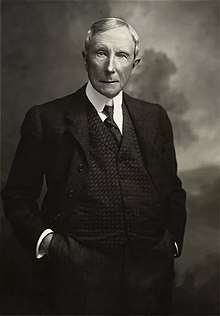
The origins of Central Philippine University dates back in 1901 when the American Northern Baptists, through its foreign mission board, the American Baptist Foreign Mission Society, laid a plan to establish mission schools following the comity agreement of the division of the islands for the evangelical mission and through a benevolent grant given by John D. Rockefeller, an American industrialist and philanthropist.[46] John D. Rockefeller himself was a devoted Northern Baptist with numerous church related philanthropy works throughout his life, that is why he gave a grant to the Northern Baptists that resulted in the establishment of Central.[9][10][11] [12][13][47][48][49]
On the other hand, in 1901 also, four years before the founding of Central in 1905, alongside when the American Baptists came in Iloilo, the Presbyterians came and they established the Union Mission Hospital (Sabine Haines Memorial Union Mission Hospital) (which Central, since its founding until this day is closely associated with as its university hospital) under the Presbyterian Church in the United States by Joseph Andrew Hall, it is the first Protestant and American hospital in the Philippines. Since the hospital's founding, Presbyterians worked closely with the Baptists for the operation of the hospital. Following the years since its founding, in 1925, its administration was eventually transferred to the Baptists who also bought the land in the City of Jaro (now part and a district of Iloilo City) where the hospital now stands. The hospital was later renamed to Iloilo Mission Hospital in 1932. The hospital predates the schools founding by four years. It also serves since then as the hospital of Central. The hospital pioneered the Nursing education in the Philippines when it established the Union Mission Hospital Training School for Nurses (the present Central Philippine University College of Nursing) in 1906. The school also produced the first graduate nurses in the country.
Then in 1903, there will be two schools that will be established by the mission: an industrial school for boys and a Bible school to train pastors and other Christian workers was incorporated. Later, it was voted on 2 December 1904 to finally establish the both schools. The task to found both schools was given to William O. Valentine, an American missionary, who became the first principal and president with the help of the other co-founders. Valentine was in the service of the American Baptist Foreign Mission Society, where he first ministered as a missionary in Burma, first in Rangoon, then in Mandalay, where he became the principal of the Baptist Mission High School for Boys in 1895. The new mission was given to him by the mission society in 1903. During his eighth year in Burma he suffered severe sunstroke and returned to America for treatment. There he met his future wife, nurse Ina Jane Van Allen. Valentine and Van Allen were married in 1903 and the couple left for his new appointment in Iloilo in the Philippines.
The establishment of the Baptist Missionary Training School and the Jaro Industrial School is associated with the first Baptist Church in the Philippine Islands, the Jaro Evangelical Church, which was established in 1900 by the Northern American Baptists also, now the American Baptist Churches. In June 1905, the Baptist Missionary Training School opened in the home of the Valentines, under the auspices of the American Baptist Foreign Mission Society from the United States alongside with other missionaries that are considered as co-founders. There were 12 pupils with some "Bible Women" who attended as auditors.[50]
The benevolent grant given by the industrialist and oil magnate John D. Rockefeller, was used to provide the school the facilities during the school's establishment along with the industrial school (which was later established in the fall of 1905) and to purchase a 24-hectare piece of land in the City of Jaro (now a part of Iloilo City) where Central's main campus is located at present.[9][10][11][12][13][51]
In the fall of 1905, the Jaro Industrial School was opened as a free vocational boarding school for poor boys.[52] The first class consisted of 20 boys who worked four hours a day to pay their tuition, room and board, and spent four hours in the classroom.[53][54][55] One of the school's innovations was the adoption of student self-government, the first in the South East Asia, known today as Central Philippine University Republic, which is modeled on American civil government. Dr. William Orison Valentine, worked for its incorporation and recognition by the Philippine Government.[56][57] A year later when Jaro Industrial School was established, one of the school's innovations was the adoption of student self-government which is modeled on American civil government, the Jaro Industrial School Republic. The Republic continues to this day as the Central Philippine University Republic. It still holds the distinction as the oldest student governing body in South East Asia.[26] The original purpose of the founding of the industrial school for boys was quoted a century later in 2005 during the centennial celebrations of the university:
"The original purpose of the school (Jaro Industrial School) was to provide opportunity for poor Filipino boys to receive a good Christian education by working their way through school. Actual work experience and earnest study of the Bible were the core of the curriculum."
Later the leadership of the Bible School was turned over to the Rev. Henry Munger, who conducted classes off campus.[50] In 1907, Reverend William Valentine became and tenured again as head of the Jaro Industrial School. By 1907 during his term, there were 300 boys working an active farm and in various trades. All of this students were required to live on campus. In 1907 also, the Bible School split off under a separate principal, Dr. Eric Lund. Classes were held at the Mission Press building where Lund was doing his Scripture translation work.
In 1910, independent student media at the Jaro Industrial School created the first official student publication, The Hoe (the present Central Echo). It is now one of the oldest student publications in the Philippines.
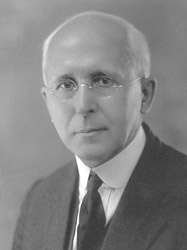
In 1912, Dr. Lund left the Baptist Missionary Training School and it was closed. Following that year, in 1913, Dr. Valentine's objectives were realized and in the same year the Jaro Industrial School also admitted its first female student; it was fully incorporated then by the Philippine government and enrolled 740 students. Then in 1915, Jaro Industrial School opened its first high school program, starting with first and second year classes, adding third and fourth year classes in 1920. As the both two schools were founded by the Northern American Baptists from the American Baptist Churches, ordination for women is affirmed[58] that resulted and eventually in 1917, the Jaro Industrial School elected its first female head and Principal, Mary J. Thomas, who tenured as a Principal of the Jaro Industrial School from 1917 to 1918. The Baptist Missionary Training School later however was reopened in 1913 by Rev. Alton Bigelow. It was under Rev. Alton Bigelow's leadership that the Bible School began to have a definite direction in its development. In 1921, the following year after the Jaro Industrial School added fourth year high school classes, the school graduated its first high school batch.[15][59]
The first Board of Trustees which was formed a year earlier before the founding of the two schools, is composed of five members from the mission conference which are selected by the mission conference in annual session. They remained American in composition until prior to the conversion of the Jaro Industrial School as a junior college. In the early years of the school's operation, building up qualified faculty and staff had been a great challenge. Some missionaries gave part-time service and Dr. David S. Hibbard, founder of the Silliman Institute, now Silliman University, also provided Filipino instructors who had trained at Silliman Institute.[55]
To accommodate the need for tertiary education in the area, a junior college was opened in 1923 and the name of the school was changed to Central Philippine College. In April of the following year, the Baptist Missionary Training School became an organic part of the junior College. The senior college opened in 1936 and by 1940 five degrees were offered: Bachelor of Arts, Bachelor of Science, Bachelor of Education, Bachelor of Theology and Bachelor of Religious Education.[15]
When the junior college became a senior college in 1936, the College of Engineering was also established.[60]
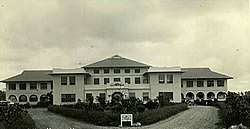
In 1938, Baptist Missionary Training School (BMST) for women which was established independently on 20 October 1905, became part of the theology department of the college.[14] In the same year also, students and interested sectors of the school began to press for the opening of a law school. Finally, on 18 March 1939, the Board of Trustees voted to apply for a permit to offer the first two years of the law course. It opened in the school year 1939–1940. Attorney Pablo Oro, who had been one of the leaders in urging this move and in seeking patrons to help develop the law library, was given the responsibility for developing the program. Pablo Oro, a member of the Philippine Bar, was a graduate of Silliman University and of the University of Manila College of Law.[61]
On 19 September 1931, the Union Mission Hospital started admitting and treating patients in its present location on Mission Road. The hospital plant occupied a lot 29,283 meters or approximately 3 hectares in area. On 21 October 1931 became a joyous day. The new relocated hospital was dedicated with its founder, Dr. Joseph Andrew Hall came all the way from Tacloban City, Leyte, as the guest of honor on the said momentous occasion. Dr. Precy Grigg lost no time in developing the new hospital's buildings and its surroundings. On what used to be a deep rice field and swampy place was a green lawn and rose garden surrounding the new imposing and neat-looking concrete hospital. After office hours, Dr. Grigg loved to work on landscaping the surroundings with plants secured from the islands of Negros and Panay.
On 5 March 1932, Union Mission Hospital (UMH) became the Iloilo Mission Hospital (IMH). Likewise the training school was renamed Iloilo Mission Hospital Training School for Nurses (IMHTSN). The hospital onwards continued to grow. It drew students from many parts of the Philippine islands who came to apply for admission to the training school for nurses.
World war II
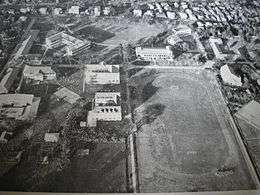
Academic life in the campus was interrupted when invading Japanese forces landed in Iloilo. As a consequence of the invasion, missionaries assigned at Central fled and took refuge in the mountain barrios of Katipunan, Tapaz, Capiz. They hid in the forest they called "Hopevale" with the help of their Filipino friends. They were eventually captured by the Japanese troops on 19 December 1943. The missionaries begged them to free the Filipino captives and instead offered themselves as ransom. At the dawn of 20 December 1943, the missionaries asked to be allowed to pray and, an hour later, they told their Japanese captors they were ready to die. The adults were beheaded and the children were bayoneted.[62]
The missionaries who died in the massacre are today called the Hopevale Martyrs. The martyrs are: Dr. Francis Howard Rose (former President and head of Central), Jeanie Clare Adams, Prof. James Howard Clovell, Charma Moore Clovell, Dorothy Antoinette Dowell, Signe Amelia Erikson, Dr. Frederick Willer-Meyer, Ruth Schatch Meyer, Gertrude Coombs Rose, Rev. Erle Frederich Rounds, Louise Cummings Rounds, and Erle Douglas. Despite the order that these Americans should go home because of the war, they refused to leave their mission and eventually sacrificed their lives.[63]
On the day Pearl Harbor was bombed on in December 1941, the American Baptist Foreign Mission and its affiliate Woman's American Baptist Foreign Mission Society had 21 missionaries in the Philippine islands. The mission works of the American Baptists had been rocked during the height of the World War II. On 15 December 1941, the two mission hospitals run by the mission on Panay – Iloilo Mission Hospital and Capiz Emmanuel Hospital, began to work in full co-operation with the United States Armed Forces. By January 1942, Manila had fallen in the hands of the Japanese Imperial Army and had become clear that they would come to Panay. The two hospitals moved to separate inland areas, the Capiz Emmanuel Hospital to Dumalag, Capiz and the Iloilo Mission Hospital to Calinog, Iloilo where, April 1942, they continued to operate under their regular missionary and Filipino staffsm drawing more heavily on the armed forces for equipment and supplies.
Post-war years and reconstruction
After the war ended, the college was reopened by the remaining members of the faculty and by returning missionaries. When the Second World War broke out, the college's buildings were destroyed. Reconstruction was made possible through funds from friends at home and abroad.[15]
The college's Graduate School was formally opened in 1951 with Dr. Linnea A. Nelson as dean. Dr. Nelson, holder of an Ed.D degree from the University of California, Berkeley, had been a missionary in China from 1935 to 1949.[64] Since its founding, the graduate school has been chosen by the fund for Assistance to Private Education (FAPE) as a graduate center for MBA, MA in English and Master of Engineering for the following fields of specialization: civil engineering, chemical engineering, electrical engineering, and mechanical engineering.
When the war ended, Dr. Henry S. Waters, the postwar director of Iloilo Mission Hospital and also principal of the Iloilo Mission Hospital School of Nursing in 1946–1947, pressed for the offering, with Central Philippine College (the forerunner of Central Philippine University), a collegiate course leading to the Bachelor of Science in Nursing degree.[22] The director of the Bureau of Private Schools and the members of the board of examiners for nurses authorized the opening of the Bachelor of Science in Nursing four-year course in 1947 that resulted the school's operation transferred to the college.[22]
Dr. Waters served as acting dean of the new College of Nursing at Central Philippine College (1947–1948). When he returned to the United States, Dr. Teofilo Marte served as the executive secretary (1948–1949). Loreto D. Tupaz, who finished her Bachelor of Science in Nursing degree at CPU, was the acting dean from 1949 to 1950 and served in this capacity until the arrival of Esther Salzman, Master of Science in Nursing and an American Baptist Foreign Mission Society missionary nurse, who held the deanship from 1950 to 1961. During her term, the college offered three curricular programs: the Bachelor of Science in Nursing four-year course, the GN-Bachelor of Science in Nursing Supplemental Course and the Bachelor of Science in Nursing five-year course.[22]
Tupaz and Salzman worked together to develop Central Philippine College of Nursing (later the Central Philippine University College of Nursing) into a college of distinction, recognized both in the Philippines and abroad. Salzman served as dean until 1961 when she retired in the United States.[22] Lily Plagata, MSN, was appointed to the deanship (1961–1974). When she resigned and went abroad, she was replaced by Carmen Centeno, Master of Science, for the remaining months of 1963.[22] Centeno, however, also left for the United States, and Loreto D. Tupaz, who finished her MA degree at CPU, resumed the deanship (1963–1970), assisted by Maria Pablico, MSN (1969–1970). Pablico also resigned to work in the United States from 1963–1973. Tupaz continued to administer the three course programs of the college, the Bachelor of Science in Nursing five-year course, the CCT (Clinical Teaching) course, and the Bachelor of Science in Nursing Supplemental Course.
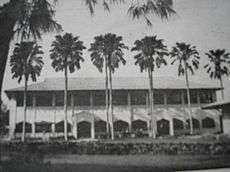
On 1 April 1953, the college gained government recognition and was given a university charter, converting the college into what is now known as the Central Philippine University.[15]
In July 1955, the Hon. Robert Simmons, the former Chief Justice of the Nebraska State Court, visited the campus and lectured to the students. He became very much interested in the former law school Dean Atty. Pablo Oro and the College of Law. Justice Simmons gave generous support to the law school's library and encouraged his friends and colleagues to do the same.[61]
In 1965, Central's College of Engineering offered a one-year Sanitary engineering course with three graduates. One could only enroll in this course after completing the Civil Engineering course. However, this restriction was abolished later due to an insufficient number of enrollees.[60] In 1956, after three years when the college received a university charter from the Philippine government, the first female President, Linnea A. Nelson, was elected.
On the other hand, Linnea Nelson became the first female university president, she was the person behind the establishment of the School of Graduate Studies back in 1951, where she was the first dean of the school. Nelson is an Ed.D degree holder from the University of California, Berkeley, and had been a missionary in China from 1935 to 1949. She served as the president of Central from 1956–1957 and was again re-elected in 1965–1966.[69]
From its founding, Filipinos were gradually given larger responsibilities in its administration.[15] In 1966 the first Filipino president, Dr. Rex D. Drilon, a CPU alumnus and a Political Scientist from the University of the Philippines Diliman, was elected. Dr. Drilon began initiatives for the Filipinization of the university, and made a trip to the United States for the purpose. The American Baptist Foreign Mission Society consented to transfer the multi-million University properties to the Filipinos in consonance with the Foreign Mission policy of "Americans receding and Filipinos advancing". Thus, in 1968 the entire university property – land, buildings, and equipment – was turned over by the American Baptist Foreign Mission Society to the Filipino corporation of CPU. Since 1973, all members of the Board of Trustees and administrative officials of the university have been Filipinos.[15]
1990s and recent history
In 1998 until 2008, the 3rd Filipino president of the university, Dr. Juanito Acanto term was dubbed as Years of Bliss: Years of Fulfillment, where academic and infrastructural developments flourished in the university, through help from the alumni. It was in his term also, when the university started a goal to raise 100 million Php and as planned, the campaign started in September 2001 until December 2005. The CPU Centennial Development Fund alone raised a total of 75,000,000 pesos from 182 Endowment programs. The helpful endeavor through other endowment fund programs, which started years back, was intensified and is still ongoing, with a total of 433 Endowment Funds, amounting to 127,500,000 pesos until May of his last year term as the university president in 2007;[70][71] celebrated its centennial year in 2005, where thousands of alumni from the world came home.[72] The university's centennial celebration and followed by the foundation day on 1 October owes a lot to the American founders and missionaries who founded and sacrificed for Central, especially to the Reverend William Valentine, the founding father of the institution.
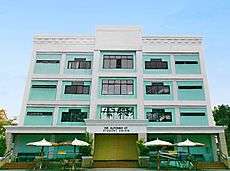
CPU–Iloilo Mission Hospital, the university hospital of Central in 2001, celebrated its centennial, commemorating its century of existence and its contribution since its founding in 1901 to the Philippine and American colonial history in the Philippines and in Asia as it pioneered the Nursing education in the Philippines, as the first Protestant founded hospital in the country and the second American hospital in Asia. The centennial building was inaugurated in the hospital area proper and the hospital acquisition of the Philips MX8000 CT Scan machine, the first of its kind in South East Asia[73]
Augmented amounts from the Centennial Development Fund and the help of various individuals, was used to build and expand the various structures on the main campus, such as the Dr. Alfonso A. Uy – Student Union Building, a four-storey commercial building built through the fund and by Dr. Alfonso A. Uy (an alumnus of the University) on the campus, to help augment its operational expenses, and to further raise its financial base; CPU Lifestyle Learning Center (prior to the students and the people who wanted to manage their fitness lifestyle); and the CPU Alumni Promenade and Concert Park, which is structurally attached to the also newly built CPU Alumni Center, CPU Alumni Affairs Office, Educational Media Center (where the CPU TV Channel and Radio broadcasts still to this day) and the CPU Dining Hall, and the CPU Excel Center.
Also, in the school year 2000–2001, the Central Philippine University College of Engineering introduced the Bachelor of Science in Software Engineering. This has earned the College another place in Engineering History in the Philippines. It is the first engineering school in the country to offer the course. On 15 August 2001 also, Dr. Ted Robles (BSEE 1964) (the present university president) and a former Milwaukee School of Engineering professor conducted a national seminar on a digital logic software known as the Altera Max + Plus II which was attended by different engineering schools in the Philippines and hosted by the Electrical Engineering and Electronics and Communications Engineering department of Central Philippine University College of Engineering.[74]
The College of Engineering hosted the first-ever National Congress on Civil Engineering. Then, a seminar workshop was held featuring Dr. Stephen Agunlana from Asian Institute of Technology as guest professor. This was followed by the two more Civil Engineering Seminars, this time featuring alumni, namely, Asian Institute of Technology based Engr. Henry Abiera (College Alumnus) on Geotechnical engineering, and Engr. Vicente Golveo (BSCE 1957) from the United States of America on Structural Engineering. Seminars on Instrumentation and Micro Controllers were undertaken with Dr. Teodoro Robles (College of Alumnus and present university president), also from the United States of America, as resource person.[74]
One of the other prominent infrastructural developments during Dr. Juanito Acanto's term as a president, is the establishment of the university's own Television Channel, the CPU TV Channel. The television channel, launched in 2001 under its former names, EXCEL TV, then was changed to CPU Alumni Channel in 2005, and to CPU TV Channel, is the first university–based cable TV channel in Asia, is one big leap in upholding the university's standard in quality education through the use of mass media.[75] There were various new real properties also that is owned by the University when he was in his term as the President. The 24 hectares San Rafael Agricultural Land[76][77][78] and the 14 hectare Guimaras Agricultural Land[79][80][81]
Central gained much attention and was lauded by various business and technology sectors in the field of Engineering, through its pioneer Packaging Engineering program and department in the College of Engineering, being the first such in the country and in Asia, organized and hosted the first National Conference in Transport Packaging in 2007 it was then followed also by the first Philippine International Packaging Conference, the Global Pack 2012.[82] Thomas Schneider, President and CEO of the 51-member nation World Packaging Organization, is one of the delegates of the Global Pack 2012 event alongside with various persons from other countries, government agencies and business sector.[83] Alongside with the Global Pack 2012 conference, a packaging engineering testing center and laboratory and value-added facility of a UN-compliant and comprehensive was donated by US Packaging Hall of Famer and Department of Science and Technology (DOST-Philippines) Balik Scientist Dr. Lejo Brana, is also the first of its kind in the Southeast Asian region, the CPU Philippine Center for Packaging Engineering and Technology (CPU-PC PET). The center is backed by the Philippine- Department of Science and Technology, the industry's Packaging Institute of the Philippines and a private sector's packaging advocate, Systemat-PackEDGE.[84][85]
The University currently expanded its numbers of programs in business, agriculture, and medical and health sciences and the recent re-establishment of the pharmacy department. The International Organization for Standardization (ISO), prior to the University as an ISO Certified Institution, recently conducted an external audit and surveillance for the University's renewal of ISO certification, based on the new standard. The University last upgraded its certification last 2010. The said University's certification, covers educational and support which is up to year 2013.[86] Recently, through international collaborations with other institutions has made CPU to offer undergraduate programs in Business Administration and Accountancy, graduate programs in Business Administration and Public Administration, and doctorate degree in Management program at Thai Nguyen University (TNU) and Thai Nguyen University of Economics and Business Administration (TUEBA) both in Vietnam.[44][45]
The university acquired also a Level IV accreditation status (the highest level of accreditation that could be given to an individual academic program in the Philippines) from Association of Christian Schools, Colleges and Universities (ACSCU) in the programs of Business Administration, Accountancy and Education, among others, has made it the top university in the Western Visayan region with programs that has a said accreditation status and level. It ranks first in the Philippines in terms of tertiary academic programs with Level III level status. The university also ranks first among other universities based on Centers of Development and Excellence list in Western Visayas, where six of its programs designated by the Commission on Higher Education (Philippines) as Centers of Development and Center of Excellence, while Department of Science and Technology (Philippines) designated its Civil Engineering program as Center for Civil Engineering Education. Central is one of the two leaders in the Visayas and Mindanao based on endowment funding, with 182 Endowment programs and a total of 433 Endowment funds in 2007 that is still on-going and expanding still to this day.[87]
Campus
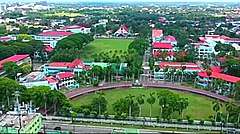
The CPU's main campus sits on a 24 hectare (59.30 acres) of land in the former city of Jaro which is now a district of Iloilo City, the largest in Iloilo City. The main campus's essential location is laid back and urban, yet away from the distraction of the progressive bustling city center and metropolis of Iloilo, which has been dubbed as the Asia's City of Love or City of Love and Emerging Museum City of the Philippines. Iloilo City is the last capital of Spanish Empire in Asia and the Pacific hence the Spanish influence could be seen elsewhere especially in culture, but during the onset years of university's founding, it had been quite a struggle but it carried thoroughly with the help and auspices of the American Baptist Foreign Mission Society. Central was established and the grant that was given by the American industrialist and philanthropist John D. Rockefeller was vital in purchasing a piece of land that the present main campus now stands. The main campus is a veritable community by itself dotted by Acacia and Palm trees with more than 30 buildings that dates back in the early years of Central's founding. The main campus plan follows a typical American university and is flanked by various gates. The second gate is the main entrance and bears the University's motto, Scientia et Fides which in English means Knowledge and Faith. Central is a registered National historical landmark by the Philippine government cultural agency of National Historical Commission of the Philippines.[26]
Some buildings on the main campus were built dating back during the early American occupation of the Philippines characterizing American colonial influence.[36] Central has been declared by the local government unit of Iloilo City as Tourist site and is the only university in the Western Visayas region recommended for tourists as a place of interest, attraction and landmark to visit by the largest travel site in the world, the Trip Advisor.[88][89][90][91] Central has been also hailed as the second of all the 18 beautiful college campuses in the Philippines by an American internet media company BuzzFeed.[92][93]
By order, the University Church is the tallest building on the main campus and meant by the planners as a "central and dominant feature" of the main campus proper. The church is notable noted for its Indonesian or Malay design and is a famous landmark in Iloilo City.[94] Henry Luce III Library is one of the largest libraries in the Philippines with more than a quartered of a million volume holdings. Inside the Henry Luce III Library is the Meyer Asian Collection holdings of artifacts and other museum and art exhibitions.
Other buildings on the main campus include the famous Rose Memorial Auditorium or Rose. Rose was built to replace the old Rose Memorial Hall which was burned down by fire in 1991. The Rose Memorial Auditorium is the largest theater in Western Visayas and has been a famous venue for different international and local kinds of musical and band concerts and conventions in Iloilo. Rose was the first annual venue of the prestigious national Bombo Music Festival when during its early years since it was established.[95][96][97][98] Recently, the Cultural Center of the Philippines has designated the Rose Memorial Auditorium for three-year Memorandum of Understanding, as one of the first batch of nine Cultural Center of the Philippines Regional Art Centers or Kaisa sa Sining Regional Art Centers in 2014, which is the only one in Western Visayas region.[37][38][39][39][40][41][42][43]
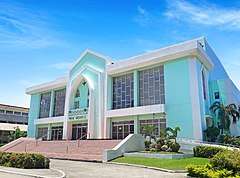
Anna V. Johnson Hall (Johnson Hall) houses the only residential college in the university. Its residents are students of the College of Theology.
The Roblee Science Hall, serves as a laboratory building, where science and laboratory experiments classes are held by the Colleges and departments of Medical Laboratory Sciences, Pharmacy, and Chemistry (also, General subjects of other Colleges held classes in Roblee Science Hall). Valentine Hall, is a monument to Central's founder, William Valentine, a Baptist missionary. It now houses the Colleges of Education and Arts and Sciences of the university[99]
CPU's main campus is enhanced by parks, gazebos, gardens and open spaces, including the Big Field, Half Moon, Alumni Garden, Santos Park, Nuñez Centennial Garden, Caipang Tree Park, Rex A. Drilon Millenium Park, the Glen at the Catedral, the Prayer Garden, the CPU-CAS Butterfly Garden, and the University Botanical Garden.
The main campus as a locally declared tourism site, the university maintains a team of landscapers and gardeners. Annually, the university showcases the Festival of Lights and Music at Central, a joint project of the university and the CPU Alumni Association. The event features lighted figurines, trees and buildings, nativity scenes, and colorful lanterns attracting thousands of local and foreign tourists during the Christmas season. The Opening of Lights (Festival of Lights and Music at Central) remains one of the notable features of the CPU campus. It opens in first week of December and is highlighted with a fireworks display on the opening ceremony. Lighted trees, buildings and figurines, Pampanga, Capiz shells and native lanterns placed along the major campus roads and nativity scenes add to its festive atmosphere.
The Central Philippine University – Iloilo Mission Hospital (CPU-Iloilo Mission Hospital), located more than a kilometer away south of the main campus in the district of Jaro, Iloilo City, sits on a 3 hectares of land. A tertiary, teaching and academic hospital, it serves as the university hospital of Central for its medical care and laboratory and clinical training center for the university's medical and allied health sciences students.
Further north, in Hopevale, Tapaz, in the province of Capiz, is the 95.8 hectare Hopevale land of the university being utilized and to be developed into an instruction, research and extension of the College of Agriculture, Resources and Environmental Sciences (CARES). The 19.3 hectare CPU Zarraga Farm (in the municipality of Zarraga, Iloilo) which is also under the said agricultural college and is separate from the university's main campus, hosts being an agricultural farm for research and extension. The CPU Crop Research Laboratory and other agricultural research facilities and equipments of the agricultural college are located in the CPU Zarraga Farm. The CPU Experimental Farm in Leon, Iloilo, which is under the college also is the site of the CPU Center for Research, Technology Development and Commercial Production of Philippine Native Chicken (CPU CRTDCPPNC), the largest research center for Philippine Native Chicken in the Philippines is located. The university villages for faculties and administration members of Central, the 2.9 hectare CPU Centennial Village (Aganan, Pavia, Iloilo) and CPU FA Heritage Ville Subdivision, are located also separately from the main campus which are both located in Pavia, Iloilo, north of the main campus. In the 1930s, the Lopez family of Iloilo through Don Ramon Lopez, donated a piece of 30,000 square meters (3 hectares) land west of Dungon Creek in Mandurriao for the establishment of the CPU College of Medicine. It was supposedly to be named as Ramon Lopez Campus but the establishment of the medical school did not materialized until 2003.
CPU's physical plant of campuses and properties are under the jurisdiction and management of the university. The 3 hectare CPU-Iloilo Mission Hospital on the other hand which is separate from the main campus, has its own Board of Trustees and Corporation independent from Central Philippine University.
Sustainability
CPU's main campus buildings are predominantly painted with eco-friendly lighter shade green color for environmental consciousness and green campus initiative plans for sustainability. The university has laid in place an Air Quality Monitoring System unit, which monitors air quality and the only unit that serves the City of Iloilo. The unit is operated jointly by the university with the Department of Environment and Natural Resources.[100] The other sustainability programs of the university on the campus include a waste water treatment facility for the waste water that is emitted then will be processed to a safer level before it will be dump back to the environment by the main campus buildings. Back in 2005, the university also launched the CPU New Millennium Tree (CPU NMT) for Sustainable Development. The said program is designed to heighten environmental consciousness on the university, where it seeks to plant thousands of mahogany trees.[101]
Academics
Presidents and administration
The Central Philippine University though founded by the Protestant Baptist Americans and affiliated with the Convention of Philippine Baptist Churches and the American Baptist Churches USA, maintains to be independent in governance and is non-sectarian in corporation. The university is governed by a board of trustees while its university hospital, the CPU–Iloilo Mission Hospital, has its own board of trustees and corporation separate from CPU.
The incumbent and 17th president (and also the 4th Filipino president) of the University is Teodoro C. Robles. An alumnus of the university, he studied engineering and graduated in 1964. If the two postwar heads Urbano F. Nequin and May A. Coggins are included, he is considered as the 19th university president or head. Dr. Teodoro C. Robles also earned his MS and Doctor of Philosoohy (PhD) degrees in Electrical Engineering at Montana State University. It was last 5 September 2008 when the Board of Trustees unanimously elected him to be the new president and it was confirmed by the CPU Corporation in a special meeting on 18 September 2008.[3][102][103]
CPU is administered by a twenty-member Board of Trustees. Incorporated as a non-stock and non-profit institution, Central's Board of Trustees is currently presided by a chairman and a vice-chairman.
| Presidents of Central Philippine University | |
|---|---|
| William Orison Valentine, 1905–1906, 1907–1914 | |
| Charles L. Maxfield, 1906–1907 | |
| Francis H. Rose, 1914–1916; 1938–1941 | |
| Henry W. Munger, 1916–1917 | |
| Mary J. Thomas, 1917–1918 | |
| Alton E. Bigelow, 1918–1922 | |
| Harland F. Stuart 1922–1938 | |
| R. Fred H. Chambers, 1941–1942 | |
| Joseph Morris R. Forbes, 1947–1950 | |
| Peter Hugh J. Lerrigo, 1950–1952 | |
| Almus O. Larsen, 1952–1956; 1957–1961 | |
| Linnea A. Nelson 1956–1957; 1965–1966 | |
| Joseph T. Howard, 1961–1965 | |
| Rex D. Drilon 1966–1971 | |
| Agustin A. Pulido 1971–1996 | |
| Juanito M. Acanto 1996–2008 | |
| Teodoro C. Robles 2008–present | |
| References | [b] |
The present director of CPU–Iloilo Mission Hospital is also a member of the board of trustees while eight of its members are from the Convention of Philippine Baptist Churches. Of the twenty Board of Trustees members, the General Secretary of the Convention of Philippine Baptist Churches sits as an ex-officio member. The CPU Alumni Association, the Faculty, and the Staff are likewise represented in the Board. The President of the university's student government, the CPU Republic, sits as representative of the students.
Rankings
The University ranks No. 1 in the Western Visayas region and No. 5 in the whole country in terms of high passing rates in various licensure examinations given by the Professional Regulation Commission.[104][105] But later than that, in 2007, a report by PRC and CHED covering a five-year period (1994–1998) named the top 10 performing schools in the country based on PRC exams and Central Philippine University ranks number 8th. CPU holds the distinction as No. 1 in the Philippines in the number of tertiary academic programs accredited Level III by the Federation of Accrediting Agencies of the Philippines.[106] In engineering, the College of Engineering ranks 10th of 25 Top Engineering Schools in the Philippines. Based also on that is the demonstration of the highest degree or level of standards along the areas of instruction, research and extension.[107]
In 2009, the Commission on Higher Education of the Philippines released a report showing the Top 20 nursing schools in country based on average passing rates in nursing board examinations. Central ranks 6th having an average of 86.72.[108]
Data released by Commission on Higher Education (Philippines) of top Universities based on Center of Excellence and Center of Development (as of 4 October 2010) for engineering courses, CPU ranks 10th of 25 Top Engineering Schools. Based on that data also is demonstration of the highest degree or level of standards along the areas of instruction, research and extension.[109] Also, based on Professional Regulation Commission (Philippines) board exam passing rates, the university's College of Engineering was listed and ranks 9th in the Philippines.[110]
uniRank, formerly 4 International Colleges & Universities, has ranked Central 21st among 217 universities in the Philippines.[111] uniRank is the official web portal of international colleges and universities, an international higher education search engine and directory which reviews over 11,000 Colleges and Universities in 200 countries around the globe. Tertiary Education Schools should be duly recognized, licensed and accredited by national ministries of education or higher education accrediting organizations before they qualify and get listed to 4icu.org. Furthermore, the organization maintains and religiously updates the profiles of the schools included in their list to protect the quality of the information contained in its directory. uniRank is a non-academic ranking body and thus it is not used to measure the academic standards of the organization. It aims to help international students know which university or college is popular in a specific country based on the popularity of their websites, which be could used as reference in selecting a higher education organization.[111][112][113]
Accreditation and designations
In aspect of academic and non-academic designations, Central has been designated by various local, national, international and government agencies like its College of Engineering being designated by the Department of Science and Technology (Philippines) as the only engineering School for Western Visayas while the College of Agriculture, Resources and Environmental as Commission on Higher Education (Philippines) – National Agriculture and Fisheries Education System (CHED-NAFES) as one of the Center of Excellence for Agricultural Education in the country.[114] The basic education department of High School is also designated as the sole Department of Science and Technology (Philippines) – Engineering and Science Education Program (DOST-ESEP) Division Leader School for Western Visayas region and likewise it is one of the 15 Network High Schools in the Philippines.
The Commission on Higher Education (Philippines) has also granted the university a full autonomy status (one of the few in the Philippines) and it is one of the few International Organization for Standardization (ISO) certified institutions in the country in which its academic programs, instruction, research and extension programs, and facilities are in accordance with or of international standards.[115]
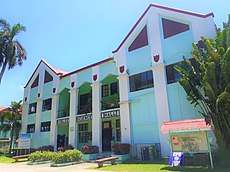
Central has been accredited by various accreditation agencies like the Association of Christian Schools, Colleges and Universities (ACSCU) where it is a founding member also, the Philippine Accrediting Association of Schools, Colleges and Universities (PAASCU), and the Association of Christian Universities and Colleges in Asia (ACUCA),[116] while the Association for Theological Education in South East Asia (ATESEA) solely for the university's College of Theology. In terms of accreditation status, the university ranks first in Western Visayas and third in the Philippines, with 15 of its programs designated as Level IV (the highest level of accreditation in the Philippines that can be granted to an individual program) in the programs of Accountancy, Business Administration, Social Sciences, Liberal Arts and Sciences, and Education.
Central has also designated by the Commission on Higher Education (Philippines) as Centers of Excellence in Agricultural Education and Business Administration and Centers of Development in Chemical Engineering, Electrical Engineering, Electronics Engineering and Teacher Education, where the university ranks first in the Western Visayas region (4th in the whole Visayas) in terms of the said number of designations.[28][33][34][35][117] The Civil Engineering likewise on the other hand has also been designated by the Department of Science and Technology (Philippines) as Center for Civil Engineering Education for Western Visayas.
Academic units
Central's academic bodies consist three graduate school/colleges, nine undergraduate colleges, the CPU Review and Continuing Education Center (a review and continuing education center),[118][119] and 3 basic education schools. Central contains also a library system, Central Philippine University Press (CPU Press), three basic education schools, while the university's medical centers are located separately from the university.
| Commission on Higher Education (CHED) Philippines Centers of Excellence (COE) |
|---|
Central is one of the two leaders in the Visayas and Mindanao based on endowment fund with current endowment between Php 150–200 million, which is specifically for research, academic and other purposes.[120] The university has more than 182 Endowment programs and with a total of 433 Endowment Funds that is still on-going.[87]
Central Philippine University is one of few private higher educational institutions in the Philippines that have been granted full autonomous status by the Commission on Higher Education (CHED), the same government agency that accredited some of its programs as Centers of Development.[29][30][31][32][121][122] CPU is also one out of few ISO certified educational institutions in the Philippines. ISO (International Organization for Standardization) is a network of the national standards institutes of 153 countries, on the basis of one member per country. The Bureau of Product Standards has been the Philippines representative to ISO, of which the said institute, has accredited the university as an International Organization for Standardization (ISO) certified institution.[29]
The University college academic programs operate on a semester system in which the academic year is divided into two terms (Including Summer [March or April–May]): July to October, and November to April. The school year typically begins in late June or early July and ends in mid-April. However, the two basic education schools of the university: Elementary School and High School, runs on a non-semester system, but has a summer term classes, offered by each basic education schools. The Senior High School on the other hand operates in 2 semesters just like the college.
Presently, the university confers bachelor's, master's, and doctoral degrees all accredited by either PAASCU (a member of FAAP), ACSCU-AAI, ACSC-AAI, ATESEA and assisted by EDPITAF in its 18 schools and colleges.
Undergraduate studies
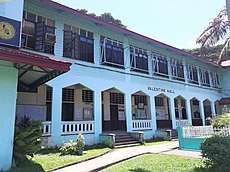
| Undergraduate schools and colleges |
|---|
Environmental Sciences |
(Dr. Lucio C. Tan College of Hospitality Management) |
The university grants Bachelor of Arts and Bachelor of Science degrees in more than 30 academic majors and including minors,[123] in nine undergraduate Colleges. Programs offered in the undergraduate level are Liberal Arts and Science, Hospitality Management, Tourism, Theology, Engineering, Business and Accountancy, Information Technology, Library and Information Science, Pharmacy, Medical Technology, Mass Communications, Public Administration and Political Science, Nursing, Teaching Education, Multimedia and Advertising, Agriculture and Environmental Sciences.
The Agriculture, Engineering, Business and Accountancy and Teacher Education programs are Commission on Higher Education (CHED Philippines) Centers of Excellence and Centers of Development.[124]
.jpg)
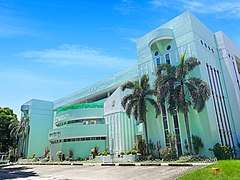
Central ranks first among other universities in Western Visayas in Commission on Higher Education (Philippines) Centers of Development and Centers of Excellence List with six of the university programs designated by the Commission on Higher Education (Philippines) as Centers of Development and Excellence.[117][126]
Recently, through international collaborations with other institutions in different countries has made CPU to offer like undergraduate degree in Business Administration and Accountancy programs especially at the Thai Nguyen University of Economics and Business Administration in Vietnam.[44][45]
- The College of Agriculture, Resources and Environmental Sciences – established by Bob Slocum, an American agriculturist. It is the first government recognized agricultural school outside Luzon. It offers undergraduate or Bachelor of Science degrees in Agriculture, Agricultural and Biosystems Engineering and Environmental Management. Accredited by PAASCU (Philippine Accrediting Association of Schools, Colleges and Universities) as Level II and is also the first and only agricultural school designated by the Commission on Higher Education (Philippines) as Center of Excellence in Agriculture in Western Visayas region. The College of Agriculture, Resources and Environmental Sciences has been also designated as CHED-NAFES provincial agricultural center for Iloilo and Panay.
- The College of Arts and Sciences – the liberal arts and sciences college of the university established in 1920s. It offers courses in Mathematics, Mass Communications, Biology, Micro-biology, Languages, Literature and Humanities. Some of its academic programs are designated by the Association of Christian Schools, Colleges and Universities Accrediting Agency Incorporated (ACSCU-AAI) as Level III and Level IV.
- The College of Business and Accountancy – established in the 1930s as one of the oldest American established business schools in the Philippines. Originally named as the College of Commerce, it was changed to its present name during the Presidency of Juanito M. Acanto. It offers baccalaureate degrees in Accountancy, Accounting Technology, Advertising, Business Administration (majors in Business Management, Financial Management (Banking and Finance), Marketing Management and Entrepreneurship) and Real Estate Management. The school is also Level IV in accreditation in some of its programs by the Association of Christian Schools, Colleges and Universities (ACSCU-AAI). The College of Business and Accountancy is the only business school in the Western Visayas region that has been designated by the Commission on Higher Education (Philippines) as Center of Excellence in Business Administration (the only Business school with Commission on Higher Education (Philippines) Center of excellence designation in the region).[127] It is also the only business school with Level IV accredited (the highest level of accreditation for a program in the Philippines) programs in Panay.
- The College of Computer Studies – established in early 2000, it is a CISCO Networking Academy and ORACLE Academic Initiative Partner computer college, it offers computing science baccalaureate programs in Computer Science, Digital Media and Interactive Arts, Information Technology and Library and Information Science.
- The College of Education – a Center of Development in Teacher Education designated by the Commission on Higher Education (Philippines) and an Association of Christian Schools, Colleges and Universities (ACSCU-AAI) Level III & IV accredited teachers college, it offers programs in Early Childhood Education, Elementary Education, Physical Education and Secondary Education (majors in English, Filipino, Mathematics, Science, Special Needs Education, Bachelor in Sports Match Analysis
- The College of Engineering – founded by Harland Francis Chandler Stuart, the 7th President of Central in 1936, it is one of the oldest engineering schools established by the Americans in the Philippines. It offers baccalaureate academic degrees in Chemical Engineering, Civil Engineering, Electrical Engineering, Electronics Engineering, Mechanical Engineering, Packaging Engineering and Software Engineering.[128] The Commission on Higher Education (Philippines) designated the college as a centers of development in Chemical Engineering, Electrical Engineering and Electronics Engineering (the only engineering school in the Western Visayas region and one of the few in the country with "center of development" designation). It is also named as Department of Science and Technology (Philippines) (DOST) Engineering school, Heat Transfer Facility and Center for Civil Engineering Education for Western Visayas region and is accredited by the Philippine Accrediting Association of Schools, Colleges and Universities. The college has various research and auxiliary centers under its umbrella which includes the CPU Affiliated Renewable Energy Center (serves the whole Western Visayas area which is funded jointly by the Department of Energy (Philippines)) and the CPU Philippine Center for Packaging Engineering and Technology, the first of its kind in the South East Asia (backed by the college's department of Packaging Engineering and the Department of Science and Technology (Philippines).) The college collaborates since 2012 in the fields of Transportation and Structural engineering research with De la Salle University. The college's programs of Bachelor of Science in Packaging Engineering and Bachelor of Science in Software are both firsts in the Philippines. The College of Engineering also ranks first among other engineering schools in the Western Visayas region based on licensure examinations and the only engineering with Commission on Higher Education (Philippines) Center of Development programs designation.[117] It has been chosen by the Educational Development Projects Implementing Task Force (EDPITAF) as one of the ten resource-based schools of engineering in the country. The college also is one of the Priority Engineering Schools in Panay, a Department of Science and Technology (Philippines) (DOST) School, Center for Civil Engineering Education, and Heat Treatment Facility for Western Visayas.[74] The college is Commission on Higher Education (Philippines) Centers of Development in Chemical Engineering, Electrical Engineering and Electronics Engineering.
- The College of Medical Laboratory Science – a newly established college in 2017 with one academic degree offered under it, the Bachelor of Science in Medical Laboratory Science, it dates back its establishment when the said academic program was founded under the College of Arts and Sciences in 1960s. The academic course from the college was folded alongside with the university's pharmacy program into when the College of Nursing was reorganized in 2014 as College of Nursing and Allied Health Sciences. In 2017, the College of Nursing stemmed into three separate colleges resulting for the medical laboratory science program to establish as College of Medical Laboratory Science.
- The College of Nursing – established in 1906 as the Union Mission Hospital Training School for Nurses by the American Presbyterian missionary and medical doctor Joseph A. Hall, the College of Nursing is the first nursing school in the Philippines. The school was incorporated from CPU–Iloilo Mission Hospital to the Central Philippine University after World War II and is thereafter up to the present, forming as one of the university's organic academic degree granting college. It offers baccalaureate degree in Nursing and graduate programs through the university's School of Graduate Studies.[129] The school's milestones include producing the first three nursing graduates, the first topnotcher and the first nursing school to become the number one top-performing school all in the history of nursing profession, education and licensure examination in the Philippines. It was renamed to College of Nursing and Allied Health Sciences in 2014. It stemmed into 3 separate colleges in August 2017 namely the College of Medical Laboratory Science and the College of Pharmacy while the college left to revert back its name to the College of Nursing.[130][131]
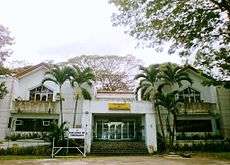
- The College of Pharmacy – a re-established college in 2017 after the College of Nursing and Allied Health Sciences was re-organized into 3 colleges, it dates back its founding years after the World War II. The college offers Bachelor of Science in Pharmacy degree.
- The College of Theology – the university's seminary, it was founded four months before the formal founding of Central's precursor, the Jaro Industrial School, in October 1905, and is the oldest degree-granting unit of the university. It is also the first Baptist theological seminary in the Philippines. The College of Theology was later merged in 1924, a year after the Jaro Industrial School became a junior college in 1923.[123] The college has two departments – Religion and Ethics and Music. It offers baccalaureate and certificate academic degrees in theology and sacred music while its graduate theological are offered through the School of Graduate Studies. The College of Theology is a member and accredited by the Association for Theological Education in South East Asia (ATESEA) and shares strong linkage with its sister theological seminary, the Silliman University Divinity School.
- The Lucio Tan College of Hospitality Management (Dr. Lucio C. Tan College of Hospitality Management) – the second youngest undergraduate and graduate academic degree granting college after the College of Medicine of Central. Forming as a part of College of Education, it separated and became Institute of HRM and Tourism in 2005. At present, it is named in honor of the famous Chinese-Filipino business tycoon Lucio C. Tan, whose endowment donation was responsible for the re-establishment of the college and expansion.[123] Accredited by the Association of Christian Schools, Colleges and Universities, it offers undergraduate academic degrees in Hospitality Management and Tourism Management.[132]
Graduate and professional studies
| Graduate and professionals schools and colleges |
|---|
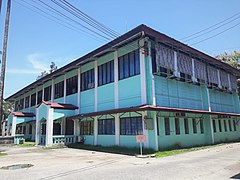
Central offers a variety of masters, diploma and doctorate academic degree programs in social sciences, business, education, library and information science, information technology, english studies & communication, liberal studies, nursing, psychology/counseling, agriculture and engineering in all schools and colleges under the School of Graduate Studies, while the Doctor of Medicine program and the bachelor's or undergraduate degree Respiratory Therapy and Health, Fitness and Lifestyle Management (HFLM) academic programs are under the College of Medicine and Juris Doctor (J.D.) and Master of Laws offered under the College of Law.
The College of Dentistry which was opened in 1948, is one of the professional degree granting schools of Central. Due to the cost the university may cover for its expansion for a modern dental school, it was closed in the 1950s.
- The College of Medicine – established in 2003, is one of the youngest colleges and professional schools of the university.[133] The Doctor of Medicine (M.D.) program was the sole academic program offered by the college but later the bachelor's programs of Respiratory Therapy and Health, Fitness and Lifestyle Management were added in the college.[134][135]
- The College of Law – established in the 1930s and confers the Bachelor of Laws (LLB) degree. In 2012 later, the college changed the Bachelor of Laws program to Juris Doctor (JD) program. The Juris Doctor (JD) program of the College of Law is the first Juris Doctor (JD) program in any Law schools in the Philippines approved by the Philippine Legal Education Board. The College of Law in collaboration with San Beda College of Law offers Master of Laws (LL.M. ).[136]
- The School of Graduate Studies – established during the Presidency of Linnea Nelson, first woman President of Central Philippine University. It offers graduate and post-graduate studies in Management (with majors in Public Management, Developmental Management, Business Management Tourism and Hospitality Management), Education (Doctorate, Master of Arts), Theology (Doctor of Ministry, Master of Divinity, Master of Ministry and Master of Theology), Public Administration, Master in Business Administration, Master in Business Administration major in Tourism and Hospitality Management, Master in Computer Science and Master of Science in Computer Science, Master of Science in Guidance and Counseling, Master in Library and Information Science, Master in Library and Information Science major in Theological Librarianship, Master in Education major in Filipino (Non-Thesis), Master of Engineering (majors in Civil Engineering, Chemical Engineering, Electronics Engineering and Mechanical Engineering), Master in Engineering (majors in Engineering Education with specialization in Chemical Engineering, Civil Engineering and Mechanical Engineering) and Master of Arts in Nursing.[137] The school is also accredited by the Association of Christian Schools, Colleges and Universities where some its programs as either in LEVEL III or IV designations. The graduate and post-graduate degrees offered are in partnership with their respective undergraduate colleges where they're specially designated.
Overseas academic units
CPU through a joint collaborative academic linkages with foreign institutions abroad, has earmarked the university to offer and established overseas academic programs in its partner universities in Macau, South Korea, Vietnam and China. The first successful collaboration of Central for its establishment of academic programs abroad is with the universities of Thai Nguyen University of Economics and Business Administration (TUEBA) and Thai Nguyen University (TNU) in Vietnam. Undergraduate and graduate academic programs jointly offered by CPU with the both institutions include Business Administration and Public Administration (Doctorate in Management). Upon the graduation of the students of the said academic programs, they receive Central Philippine University and joint partner institutions academic diplomas and are automatically inducted as members of the CPU Alumni Association and the respective partner universities in they graduated.[44][45]
Basic education
Central offers basic academic programs in Kindergarten, Elementary School, Junior High School and Senior High School. The university's two basic education departments, the Kindergarten and Elementary are both accredited by ACSCU-AAI as Level II while the Junior High School as Level III. The junior high school department of the university, except that it is Accredited by ACSCU-AAI as Level III, it is the only EDPITAF-assisted and DOST/ESEP[138][139] Division Leader School by the Department of Science and Technology for Western Visayas. The Junior High School was also chosen as one of the few 15 Network High Schools in the Philippines[140]
The university in accordance with new Kindergarten to 12 Basic Education program (K+12) by the Philippine government so that the Philippine educational system be aligned and par with the educational systems abroad like in the United States, Europe and other countries established the Senior High School department. The Senior High School department offers General Academic Strand (GAS) under the Academic track of the new Philippine K+12 (Kindergarten to 12 Basic Education program).[141][142]
Library system
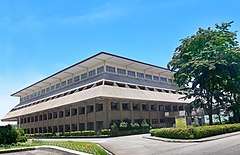
Central's main library, the Henry Luce III Library encompasses the university's library system, which is composed of departmental and college libraries of Theology, Business and Law, Graduate Studies, High School and the Elementary school. Currently, the Henry Luce III Library holds more than 200,000+ volumes including holdings of special collections like the 40,000 United Nations Documents, World War II Documents, American Studies Resource Center, Meyer-Asian Collection, Food and Agriculture Organization and Elizabeth Knox Sacred Music Collection.[143][144] At present, the Central Philippine University Library is the biggest library in Western Visayas (one of the largest in the Philippines) in terms of volumes and holdings.
The Henry Luce III Library's (main library) structure was built by virtue of a grant given by Henry Luce III, a known philanthropist, and elder son of the founder and editor-in-chief of Time Inc., through the Henry Luce Foundation.[145] It has been designated by the Philippine National Statistics Office on 20 April 1997 as National Statistics Office (NSO) Information Center for Western Visayan region.[145] Consortium with the Silliman University library and the Trinity University of Asia through ACCORD Library Interconnection started in 2000. CPU Library's formal linkage in December 2002 was started with LIBRARY LINK, based at the Filipinas Heritage Library (in Makati City), on Filipiniana materials.[145]
Through linkages, Central Philippine University Library is a depository of the United Nations and the Food and Agriculture Organization (FAO). The library is a regular recipient of library materials from international and local organizations and centers such as the United Nations Educational, Scientific and Cultural Organization (UNESCO), Population Council in New York, National Library of the Philippines in Manila, Australian Centre for Publication Acquired for Development (ACPAD), Population Information Network, and the International Rice Research Institute (in Los Baños, Laguna, Philippines). Through the library system's American Studies Resource Center (ASRC), the only for Western Visayas and one of the few in the Philippines, which is located in the main library (Henry Luce III Library), is also a regular recipient from the: Thomas Jefferson Information Center (where the library has the said and one of the only 13 such centers in the Philippines) in Manila, and the United States Information Service. The American Studies Resource Center (ASRC) helps/assists students who want to study in the United States through its Educational Advising Program. A Knowledge for Development Center, donated by the World Bank in consortium with the University was launched in 2008[146][147] The CPU World Bank – Knowledge for Development Center is one of the few such centers which are hubs for dialogue and research on development issues established by the World Bank in key cities around the country in partnership with leading state and private universities.[148] The main library is also the Philippine Institute for Development Studies (PIDS) repository for Western Visayas.[149]
Medical centers
CPU–Iloilo Mission Hospital serves as the university hospital of Central. The hospital is separate and distinct in entity which operates independently from the university with its own board of trustees and corporation. Although serving as community hospital in general, CPU–Iloilo Mission Hospital serves as a training, teaching and as a laboratory facility for various medical-related internship; off-campus classes programs of the University colleges and departments of Nursing, Medicine, Medical Laboratory Sciences, Pharmacy and other allied health sciences, while the College of Theology (for its chaplaincy program); and supports the whole medical needs of the whole university.[150][151][152] the former President of the university, Juanito Maca Acanto, serves as the CPU–Iloilo Mission Hospital's chairman.
There is also the CPU Birthing Center which is located on the main campus that operates with medical and healthcare staff both from the university and CPU–Iloilo Mission Hospital. The CPU Birthing Center was built to serve the surrounding community exclusively for pregnant women. Central Philippine University also through its College of Nursing maintains a linkage with the Capiz Emmanuel Hospital in Roxas City, Capiz. The hospital was also founded by Baptist American missionaries in 1913 which serves at present as the university hospital of the Filamer Christian University. Two other auxiliary medical/healthcare institutions of the university include the CPU Clinical Laboratory and CPU Kabalaka Reproductive Health Clinic also on the university's main campus (just like the CPU Birthing Center, the both are manned by healthcare workers serving the sorrounding community).
CPU–Iloilo Mission Hospital sits on a 7.56 acres (3.0 hectares) of land in Jaro, Iloilo City. The 230–300 bed hospital's location is separate from the main campus of the university. It offers a wide array of comprehensive medical and allied health services available to the university's students and to the community in general. It was established in 1901 by Joseph Andrew Hall, a Physician and missionary under the Presbyterian Foreign Mission Board, to serve as a venue for the treatment of health care to the very poor, and has the distinction today as the first Protestant and American hospital in the Philippines.[153]
The hospital transferred locations many times since its founding. First at Ledesma Street (Calle Amparo) as a small dispensary and at Iznart Street where the present Young Men Christian Association (YMCA) is currently located. The third and present site where the hospital stands, is a property bought by the American Baptist Foreign Mission Society in Jaro District in 1931.
The hospital pioneered nursing education in the country through the establishment of in its Union Mission Training School for Nurses in 1906, the first nursing school in the Philippines. After World War II, the school for nurses was transferred to Central Philippine University and eventually renamed as Central Philippine University College of Nursing. It also produced the first with three nursing graduates, and the first topnotcher and board passer in the history nursing education, licensure examination and profession in the Philippines.[153][154]
Recent expansion of the hospital includes a 2-storey CPU-IMH Medical Education Training Center (CPU-IMH METC) for CPU's College of Medicine, 4-storey modern (IMH) Iloilo Mission Hospital Medical Arts Building and the 7-storey modernly designed Iloilo Mission Hospital Medical Center (IMH Medical Center) which will open in July 2020.
Research and extension
The university, has an active research and extension program that cover various researchers and extension activities. Central collaborates since then with various national and local government agencies, non-profit organizations, international and local industries and institutions for research in different fields.
The University annually holds a Research and Development Week.[158][159] In 2006, the Philippine Commission on Higher Education (Philippines) (CHED) awarded CPU Research Center research program as one of the 2006 Best Higher Education Institution (HEI) Research Program in the country and the lone awardee from Region 6. In 2011 also, the university received the Best Higher Education Institution Research Program Award and a Plaque of Recognition as 1st Regional Qualifier for Best Higher Education Institution Research Program (BHEIRP) by the said Philippine government agency for higher education, the Commission on Higher Education.[160] The University is also identified and designated by Commission on Higher Education-National Agriculture and Fisheries Education System (CHED-NAFES) through its College of Agriculture, Resources and Environmental Sciences as the Iloilo-Provincial Institute for Agriculture, where being the host of the annual Regional CPU-Department of Agriculture (Philippines) Agri Research Fair and Exhibits.[161]
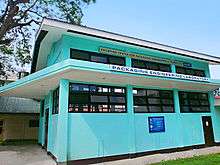
Originally the CPU Research Center lodged as an integral part of the CPU Outreach Center. In 1998, it was separated with the CPU Outreach Center. It was established to coordinate the research activities of the different colleges and units of the university and to convene and facilitate the affairs of the University Research Committee (URESCOM). Since its inception in 1998, CPU Research Center was able to enhance the competency of students, faculty and staff members in conducting research and in applying and disseminating information and findings for the benefit of its constituency and the community. The university's Institutional Research Program (IRP), through the CPU Research Center, which provides undergraduate and graduate students, faculty and staff with research opportunities for personal and intellectual growth yielded 119 bounded research reports, 53 ongoing institutional researches, and more than 100 faculty and staff were involved in research projects in 2005–2008, and still expanding to this day. The capability building programs that were regularly conducted increased faculty involvement in research.[162] One major indication that the CPU Research Center and CPU links with the industry and business sector has grown stronger was the signing of a memorandum of agreement between the CPU Research Center (URC) and the Iloilo Chamber of Commerce in 2003. The agreement was about CPU Research Center's role as the sole consultant, researcher or trainer for the Iloilo Chamber of Commerce.[163]
Under the CPU Research Center, the university published two research journals – the Scientia et Fides and Patubas and one research newsletter – the CPU Research Newsletter. The Scientia et Fides: Journal of Multidisciplinary Research and Review is the official journal of Higher Education Publication of the university and is internationally refereed and publishes semi-annually in print and online platform through the university's website. Patubas research journal is a refereed multidisciplinary research journal that aims to provide a source of information in the areas of agriculture, natural resources and the environment; social sciences, humanities and the arts; physical and biological sciences; business and management; engineering, information and communications technology; education; health, nursing and medical education; alternative medicine; theology and biblical studies; institutional system and process management; and community baseline impact studies. The objective of the journal is to help education professionals and decision-makers disseminate information and learn from each other's work.
Patubas is an Ilonggo word for "product" or "fruit", a fitting description for this multidisciplinary research journal which is indeed, a product or fruit of labors of researchers or the "seekers" of the truth in its varied dimensions. Patubas is published once a year under the auspices CPU Research Center.
In 2008, Rolex Award for Enterprise awarded the university alumni, professor, inventor and agricultural engineer Alexis Belonio due to his creation of a low-cost and environment friendly invention of the rice husk stove.[164][165][166][167] Engr. Belonio is the first Filipino awardee of Rolex Award for Enterprise that has resulted the establishment of the Center for Rice Husk Energy Technology (CRHET) (Iloilo Rice Husk Center) at Central.[168] The research center is attached to the College of Resources and Environmental Sciences and since it was established, it focuses on various technologies that will be developed and the utilization of rice husks as fuel and clean energy for cooking. The CPU Center for Rice Husk Energy Technology (CRHET) obtained funding from the Rolex Awards for Enterprise 2008.[169][170]
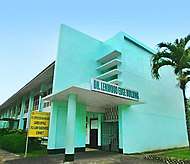
CPU is also the Department of Energy (Philippines) Affiliated Renewable Energy Center (CPU-AREC) for Western Visayas.[155][156][171] The center is one of the most active among the 14 such in the whole Philippines and is funded by the Philippine Department of Energy and the university where it aims to provide research, extension, education for renewable energy with outreach programs and projects to electrify isolated and non-isolated places in Western Visayas region.
The University also has a Rockefeller Endowed Soils Analysis and Testing Laboratory.[172][173] The university is also the sole Philippine Department of Science and Technology (Philippines) heat transfer facility for Western Visayas and collaborates since 2012 with De la Salle University in the fields of transportation and structural engineering research through the Central Philippine University College of Engineering.[157]
Through the College of Engineering also, the CPU Philippine Center for Packaging Engineering (CPU PC-PET), a packaging testing center and laboratory facility which is the first of its kind in the Southeast Asian region was established in 2012, in which Central gain attention in the fields of science and technology and breakthrough for Packaging Engineering research and development in the country and South East Asia. The center is backed by the Department of Science and Technology, the Packaging Institute of the Philippines and a private sector's packaging advocate, Systemat-PackEDGE.[85]
| Research and Extension Centers |
|---|
Commercialization (CPU-CIRAC) |
Indigenous Peoples Studies (CPU-CLGIPS) |
and Commercial Production of Philippine Native Chicken (CPU-CRTDCPPNC) |
Technology (CPU-PCPET) |
As the Western Visayas region is the leading producer of Native Chickens in 2011 in the Philippines, the university's created a partnership with the Philippine Department of Agriculture along with its College of Agriculture, Resources and Environmental Sciences for the research and development of Philippine Native Chicken in the country through the establishment of the CPU Center for Research, Technology Development and Commercial Production of Philippine Native Chicken.[174] The research facility or center is the largest research station for Philippine Native Chicken in the Philippines, it is located separately from the main campus and occupies the entire 7 hectare CPU Experimental Farm in the town of Leon, Iloilo. The center is facilitated by the Western Visayas Agriculture and Resources Research and Development Consortium (WESVARRDEC) and funded by the said government agency (Department of Agriculture) and the Philippine Council for Agriculture, Aquatic, Forestry and Natural Resources Research and Development (PCAARRD).[175]
The endeavor of the research and development of the Philippine Native Chicken through the CPU-CARES Research Station for Philippine Native Chicken made Dr. Jaime Cabarles, the CPU College of Agriculture, Resources and Environmental Sciences dean and head of the research facility the 2014 Commission on Higher Education (Philippines) Republica Award National Winner in Natural Sciences and Agriculture category, due to his significant contribution as researcher (Research and Development of Philippine Native Chicken) to Natural Sciences and Agricultural research in the Philippine society.[176][177]
Other research and auxiliary centers and extension programs of the University includes the CPU Center for Ideation, Realization and Commercialization (CPU CIRAC or CPU TechHub), CPU Research and Developmental Learning Center (Building), CPU Center for Local Governance and Indigenous Peoples Studies;[178] CPU-World Bank Knowledge Development Center (CPU WB-KDC); CPU Appropriate Technology Center (CPU-APPROTECH);[179] CPU Crop Research Laboratory; and the CPU – Social Science Research Institute.
Cultures and traditions
Central spirit
"Central Spirit" which has purportedly served as "a social glue", is a term for camaraderie, unity or reminisce the fond school day memories and activities at Central that has become symbolic of the bond that unites Centralians. Central Spirit is also contrast to what Central was founded for over a century before by the American missionaries and the school's vision. Moreover, there is also a song titled "Central Spirit" which was composed by one of the school's former American presidents, Dr. Francis H. Rose.[180]
Scientia et fides
Central's motto: Scientia et Fides literally means Knowledge or Science and Faith in English. It was chosen by the third head of Central, the late American clergyman Dr. Francis Howard Rose, as contrast and coincides to the institution's Christian foundation and belief, which was founded by the pioneer, The Rev. William Orison Valentine.[181][182]
"Scientia" – Science is viewed from the standpoint of Christian understanding that God is the creator and sustainer of everything.[182] Science is an avenue where one would know, understand, and appreciate the scope of God's handiwork as well as explore the magnitude of its potentials for the good of mankind.
"Fides" – Faith is basically a gift from God. And as a gift, the exercise of such faith will find meaning and purpose within the sphere of God's sovereign plan and direction. In this regard, such kind of faith becomes active and dynamic.[182] It inspires, influences, and transforms anything that comes in contact with as it continually seeks understanding and expresses itself in noble actions that aim to glorify God.
Gold and blue
.png)
Gold and blue are both official and athletic colors of Central since it became a Junior College in the early 1920s. Gold regards to its "Scientia" motto as "Excellence" and contrast to the Biblical standpoint alongside with blue for "Spirituality" (from its "Fides" motto) when chosen as the official colors of Central in the 1920s. Both reference Biblical texts from the books and chapters of 1 Corinthians 3:12–13 and Ephesians 2:20 (for gold) and Numbers 4:6–7, 9,11, 12; 15:38–40 and Exodus 25:4; 26:1, 31, 36; 28:28, 31 (for blue).[183]
Festival of Lights and Music at Central

A month long-fete festival of lights and music which is an attraction every December for the Christmas season in the City of Iloilo that has become a tradition for more than a decade at Central, is held annually since 1998. The main campus major streets and buildings are festooned with Christmas lights during the festival and is flocked by visitors or tourists. The festival, starts traditionally in the first week of December, where at the opening night, a traditional switching on of Christmas lights is followed by a grand fireworks display. On the second night after the opening, A Christmas musicale and a signing contest opens with contestants not only from the university but from the surrounding community.[184][185]
University and foundation day
In 2015, although for many years the University Day festivity was celebrated in August until September, it was moved and combined with the Foundation Day that starts from September and ends in the first week of October. The festivity characterized with intramural games between colleges and schools that starts in September, the annual famous Mr. and Ms. CPU pageant, a university picnic and concerts at the Promenade (Alumni Promenade and Concert Park). At the last days of the celebration is the Foundation day which is held every 1 October where the university commemorates its founding by the American missionaries as the Bible School and Jaro Industrial School, Central's two forerunner schools in 1905. The commemoration characterized also with a civic parade, a memorial service for the founding father of Central William Valentine and his co-founders, the traditional singing of the Star Spangled Banner along with the raising of the flag of the United States and the Philippines.[186]
Pinning, capping and candle lighting ceremony
Capping and Candle Lighting Ceremony is a unique tradition pioneered College of Nursing has pioneered which was later followed by some nursing school in the Philippines. The tradition dates back in the early years when the college was founded in 1906 as the Union Mission Hospital Training School for Nurses. Held at the end during the junior year of the nursing students at Rose Memorial Auditorium, the tradition involves involves students don their CPU-Iloilo Mission Hospital nursing uniforms, the lighting up of candles and the placement of a nursing cap on the heads of women nursing students.
The Pinning ceremony on the other hand happens before the commencement exercises of a graduating nursing students. A Centralian Nurse Pin is bestowed upon the graduating student nurses in the said ceremonial tradition. It symbolizes that the student nurse has satisfactorily completed her training and is now ready to work as a professional nurse. The Directors of the Nursing Service of the different affiliated hospitals which includes the university's hospital CPU-Iloilo Mission Hospital as well as the College's faculty members present the pin to the graduating nurses. The design of the pin bears the logo of the college. The pin is a circle enclosed in laurel leaves which symbolizes excellence and the university's vision of Exemplary Christian Education for Life (EXCEL).
Each Centralian nurse is called to serve the profession with excellence and to embody the Christian ideals taught by the Alma Mater. The upper half of the other circle burst the word "Iloilo Mission Hospital" to signify the roots of the college – the Union Mission Hospital (Iloilo Mission Hospital) Training School for Nurses, the first nursing school in the Philippines. The lower half of the circle bursts the word "Nursing" to signify the profession. The inner circle has the acronym CPU which stands for Central Philippine University, the Alma Mater. The pin is made in gold and with the letters, CPU, in blue, the two being the colors of the university. The tradition has been also pioneered by the college which other schools of nursing education education followed.
Athletics
Central is member of the Private Schools Athletic Association (PRISAA) and the Philippine University Games (UniGames). The university's athletic nickname, Golden Lions represents the university in athletic games.[187][188]
The Golden Lions which is established through a proposal by the Reverend Francis Neil G. Jalando-on, Coach of the College Table Tennis Teams and Associate Pastor of the University Church, is based on the following Bible verses in contrast as the university was founded by the American Baptist missionaries: (Proverbs 28:1) "The godly are as bold as lions", (Proverbs 30:30) "The lion, mighty among beasts, does not retreat from anyone", (2 Samuel) 17:10 "The bravest are those whose heart is like the heart of a lion", (Revelation 5:5) "The Lion of the tribe of Judah, the Root of David, has triumphed" — JESUS is the Lion of Judah.
Central has adequate playgrounds and facilities for sports and athletic activities.
The CPU Gymnasium (Central Philippine University Gymnasium) is the largest university and athletic gymnasium in Western Visayas and can serve as a venue for the following sports: basketball, sepak takraw, badminton, table tennis, lawn tennis, and volleyball. CPU Gymnasium has also can host musical, live and band concerts. The CPU Gymnasium been the official home of the official athletics team of Central and is called The Lion's Den, the CPU Golden Lions. Outdoor sports such as soccer and softball can be played at the football grounds, CPU Softball Field and the ground situated at the Half-moon Drive.
The University hosted the 14th Philippine University Games (UniGames).[189] There is also an Olympic size CPU swimming pool for swimming competitions. The University main campus can accommodate Triathlon sports event. The University Tennis Courts is also available for use by students and tennis enthusiasts. CPU's Olympic-sized swimming pool is the most modern and biggest school-based pool in Western Visayas. It provides a very convenient swimming area for PE students, athletes, alumni and friends of CPU. Central Philippine University is famed for its football games.
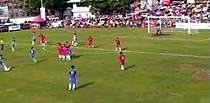
The CPU International Football Team, composed of foreign students who are studying at Central matched with the Philippine Football Federation team (Azkals) in 2010 in Barotac Nuevo, Iloilo. Most football players of Central are under the roster of Stallion F.C., a club that plays for the United Football League (UFL) and is also affiliated with Iloilo F.A. (IFA). CPU also hosted the PFF Smart Club Championship-Group B on 9–13 August 2011 which was facilitated by Iloilo Football Association wherein the university is one of the hosts venue.[190]
In April 2012, the Western Visayas (PRISAA) Private Schools Athletic Association – Softball team,[191] composed wholly and represented by Central's Softball team, defeated the regional teams including the last contingent (Region 10) and wins second time since 2011 with the Gold medal in the 59th National PRISAA Championship. The 59th National PRISAA was held in Cebu City in 2012.[192][193]
Student life
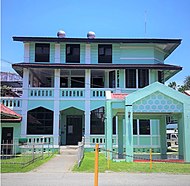
Student organizations
Students are encouraged to form groups that enhance their desire for study. The Student Organization Committee (SOC) acts as the regulatory body for all student campus organizations. It approves the registration and supervises the activities of student campus organizations. These include religious and cultural groups, academic and athletic clubs and groups. Notable organizations are: Central Philippine University Republic (CPU Republic), official student governing body of the university (the first student government in the Philippines); CPU Parliamentarian Society; the Central Echo; CPU Bahandi Singers; CPU Handbell Choir (the first and only 5-octave handbell choir in the country); and CPU Mountaineering Society. There is also a Foreign Students' Organization that assists the university to invite more foreign students to attend Central.
Fraternities and sororities
There are more than 10 fraternities and six sororities that are local, international or founded in the university that maintains their chapters at Central, as well as fraternity for those who are taking a Juris Doctor (J.D.) course, the Order of Kalantiao, and Phi Beta Epsilon for the students of the College of Engineering.[194]
Student and faculty housing
Various apartment facilities, such as dormitories and housing commons, are located on the university's main campus that could provide living accommodations to students. The Franklin Hall (men's dormitory) and Weston Hall (women's dormitory) are the two known residential commons that can accommodate a total capacity of 300–400 students. The Anna V. Johnson Hall (Johnson Hall), a former edifice which houses the College of Theology, is now a residential commons exclusively for the students of the said seminary. Other residential halls for Central students include the Roselund Hall (Roselund Hostel), the Gonzaga Hall (Gonzaga Mansion), the Executive House, and the Missionary Hall. [195] The Missionary Hall is the latest addition to the university's expansion of building residential commons on the main campus to cater its growing number of students.
The American Village, a residential village located within the premises of the university's campus, has also renovated halls and housing units catering to the growing demand of foreign students who are studying at Central. The village has also residential units for the university faculty and staff.
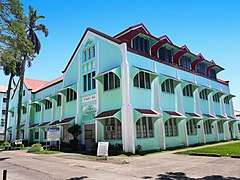
There's also two residential villages located separately from the university's main campus in Jaro – The CPU Centennial Village, [195] a 2.9 hectare residential village for the university's faculty and staff members has 185 saleable units with 6 types of housing models[196]; and the CPU FA Heritage Ville Subdivision/CPU Heritage Subdivision, another residential subdivision of the university located few kilometers away east of the CPU Centennial Village in Anilao, Pavia, Iloilo, which just like the latter, also provides residential housing units with community amenities for the faculty and administrative staff of the university.
Living in the dormitories and villages is considered a privilege that is granted to the students and faculties who comply with the rules and regulations of the University. Formal admission procedures is followed before admitting anyone to the dormitories. For university villages, the housing units are given by the university to the faculty members and staff.
Publications
The Central Echo[197] (CE) is the official student publication of CPU.[198] It was founded in 1910, five years after Jaro Industrial School opened. Established originally as The Hoe, The Central Echo evolved to be one of the best college student publications in the Western Visayas region: It has been recognized as Second Best Magazine and Fifth Best Newspaper by the Philippine Information Agency-Region 6 in 2009.[199] Central Echo publishes and circulates newspaper twice in a regular semester, it publishes magazine also, an art portfolio (Paraw) and a summer literary folio every summer. Other publications of the university include The Centralite, the official yearbook; The Central Post, the official publication of the office of the university president; and the Central High Echo, the official publication of the High School Department.
Every college in the university has its own publication.[197] Some of the student writers are associate members of the Iloilo Press Club and the College Editors Guild of the Philippines.[197]
Notable alumni
People associated or affiliated such as students, faculty members, administrators, honorary degree holders, or other people with Central are called Centralians. The university maintains an alumni association with various chapters throughout the country and different countries abroad.[200]
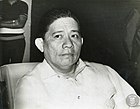 Rodolfo "Roding" Ganzon, Senator of the Philippines.
Rodolfo "Roding" Ganzon, Senator of the Philippines._(cropped).jpg) Perfecto Yasay Jr., Secretary of Foreign Affairs of the Philippines and 2010 Philippine elections vice-presidential bet.
Perfecto Yasay Jr., Secretary of Foreign Affairs of the Philippines and 2010 Philippine elections vice-presidential bet..jpg) Franklin Drilon, Filipino politician (senator) and Senate President of the Senate of the Philippines.
Franklin Drilon, Filipino politician (senator) and Senate President of the Senate of the Philippines.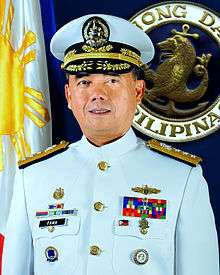 Alexander Pama, Vice-Admiral of the Philippine Navy and Undersecretary of the National Disaster Risk Reduction and Management Council (NDRRMC) of the Philippines.
Alexander Pama, Vice-Admiral of the Philippine Navy and Undersecretary of the National Disaster Risk Reduction and Management Council (NDRRMC) of the Philippines.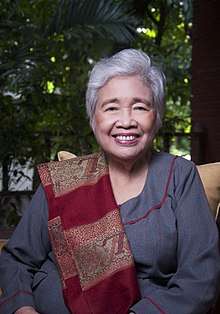 Leonor Briones, Secretary of the Department of Education of the Republic of the Philippines under President Rodrigo Duterte.
Leonor Briones, Secretary of the Department of Education of the Republic of the Philippines under President Rodrigo Duterte.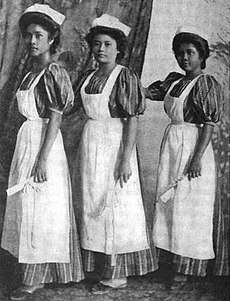 Nicasia Cada, Felipa de la Peña, and Dorotea Caldito, the first graduate nurses of the Philippines.
Nicasia Cada, Felipa de la Peña, and Dorotea Caldito, the first graduate nurses of the Philippines.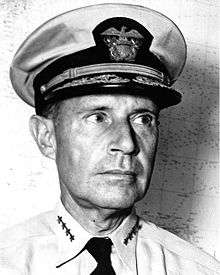 Raymond A. Spruance, United States navy admiral and American ambassador to the Philippines.
Raymond A. Spruance, United States navy admiral and American ambassador to the Philippines.
Notable alumni in politics and public service as figureheads or statesmen include Ferdinand Marcos (10th President of the Philippines), Rodolfo Ganzon (first popularly elected City Mayor of Iloilo and Senator), Franklin Drilon (Filipino Senator who also served as the President of the Senate of the Philippines)[201] and Claro M. Recto (former Filipino Senator).
In judiciary service include Calixto Zaldivar (former Associate Justice of the Supreme Court of the Philippines, Congressman, Governor of Antique province and executive secretary of the President of the Philippines)[202][203], Lily V. Biton (Associate Justice of the Court of Appeals of the Philippines)[204] and Reynato Puno (22nd Chief Justice of the Supreme Court of the Philippines).
In the public service who held positions as executive cabinet members and national government agencies secretaries, under-secretaries and heads include Perfecto R. Yasay, Jr. (Foreign Affairs Secretary of the Philippines, SEC chairman of the Philippines (1995–2000) and 2010 Philippine Vice-Presidential candidate), Leonor Briones (National Treasurer and Secretary of the Department of Education (Philippines) under the administrarion of Philippine President Rodrigo Duterte)[205], Gregorio Licaros (fourth Governor of the Central Bank of the Philippines from 1970 to 1981), Rene Cartera Villa (former acting chairman of Local Water Utilities Administration of the Philippines)[206]; Hansel Didulo (Assistant Secretary of Department of Agriculture (Philippines)); Hope V. Hervilla (Assistant Secretary of the Department of Social Welfare and Development (Philippines)), Nielex Tupas (public Servant, politician and Chief Operating Officer and Executive Director of the National Youth Commission of the Philippines), and Peter Irving C. Corvera (Department of the Interior and Local Government (DILG) – Philippines Undersecretary for Public Safety and Presidential Medal of Merit (Philippines) awardee). [207][208]
In legislative and local governance, other known alumni include Estrellita B. Suansing (Nueva Ecija 1st District congresswoman)[209], Horacio Palma Suansing (Sultan Kudarat 2nd District congressman), Edgar T. Espinosa Jr. (Congressman representing the province of Guimaras), Arthur Defensor, Sr. (Governor of Iloilo province)[210], Ferjenel Biron (former Congressman of Iloilo's Fourth District and author of the cheaper medicines bill)[211][212], Hernan Biron, Jr. (Iloilo fourth district)[213], Richard S. Garin (Iloilo first district congressman and former Vice-governor of Iloilo Province)[214][213], Pablo Nava III (Append Partylist)[213], Daisy Avance-Fuentes (former assemblywoman and present Governor of South Cotabato)[216] Salvacion Z. Perez (former congresswoman candidate and Governor of Antique Province)[217], Joshua Alim (Iloilo City councilor and 2019 Philippine Elections Iloilo City congressman political bettor), Jed Patrick Locsin Escalante-Mabilog (former mayor of Iloilo City and World Mayor Award finalist from the Philippines), and Geronimo "Jerry" P. Treñas (Former congressman and mayor of Iloilo City).
Alumni in foreign service include Leo Tito Ausan Jr. (Assistant Secretary for Legal Affairs of the Department of Foreign Affairs (Philippines) and former Philippine Consul General to Germany).[218] and Enrique Zaldivar (former congressman and Philippine Ambassador to Brunei).[219]
Alumni in business and industry include John D. Rockefeller (Benefactor of Central Philippine University and American business magnate and philanthropist widely considered as the the richest person in US history and the richest person in modern history,[220][221][222][223][224][225][226][227][228][229][230] Lucio C. Tan (Chinese-Filipino business tycoon),[231] and Alfonso A. Uy (Chinese-Filipino businessman, former and first President of Federation of Filipino Chinese Chambers of Commerce & Industry from the Visayas and Mindanao, and recipient and awardee of the Dr. Jose Rizal Award for Excellence in Business and Commerce).[232][233][234][235][236][237]
Centralians as laureates of prestigious awards and in the field of social sciences, invention, and science and technology include Jose V. Aguilar (the first Filipino recipient of the Ramon Magsaysay Award (Asian equivalent of Nobel Prize) and also first awardee of the said award (Ramon Magsaysay Award) for Government Service category for his work as the "Father of the Community School Movement". He served also as a consultant on Elementary education and later to the UNESCO Consultative Mission to the Philippines),[238] Alexis Belonio (Filipino inventor, engineer, scientist and the first Filipino Rolex Award for Enterprise awardee. He was included also by the Rolex watchmaking company on its list of 10 model innovators in November 2008. He is also one of the first seven modern day Filipino heroes awardees and recipient of the first ever Yahoo! Philippines Pitong Pinoy Awards in 2011 and part of the 25 Heroes for Better during the 25th anniversary of the Western Union Philippines),[239][240][241][242][164][243][165][166][167][244] Felipe Landa Jocano (historian and dubbed as the first and foremost Filipino Anthropologist),[245][246][247][248][249][250][251][252][253] and John Elmer Loretizo (inventor and 2017 grand winner of National Geographic’s "Everyday Genius").[254]
National Artists of the Philippines alumni of Central include Ramon Muzones (Hiligaynon fictionist, writer and 2018 National Artist of the Philippines (National Artist) for Literature)[255] and Leonor Orosa-Goquingco (National Artist of the Philippines for Dance, Mother of Philippine Theater Dance and Dean of Filipino Performing Arts Critics. She was the first Filipina and the only dancer sent on the first-ever cultural mission to Japan (1939) and the first Philippine folkloric ballerina or ballet dancer).[256][257]
In the military service include Alexander Pama (retired Vice-Admiral of the Philippine Navy and Undersecretary of the National Disaster Risk Reduction and Management Council (NDRRMC) of the Philippines)[259], Hector Tarrazona (former colonel of the Philippine Air Force, founding member of the Reform the Armed Forces Movement, 2010 senatorial candidate under Ang Kapatiran Party, and consultant/chief of the Airmen Examination Board at the Civil Aviation Authority of the Philippines)[261], Ezra James Enriquez (former Chief of Staff of the United Nations Disengagement Observer Force (UNDOF) during the Golan Heights standoff in Middle East)[262], Custodio Parcon Jr. (Philippine Navy Lieutenant Colonel and one of less than 20 graduates of the Philippine Military Academy to have awarded the prestigious Philippine Medal of Valor by the President of the Philippines)[263][264], Elvegia Ruiz Mendoza ("first female General in the Armed Forces of the Philippines" and Florence Nightingale Awardee from the International Red Cross)[265][266] and Ramona Palabrica – Go (United Nations Consul General and the first female General in the Philippine Army. Other than such position and distinction that she held, Go was also the first female military pilot, first female line officer, and the first female battalion commander in the Philippines).[267][268][269][270]
In the sector of journalism, broadcasting, media, press and writing include Danny Fajardo (the President and founder of the Philippine renowned and leading newspaper Panay News)[271], Rosendo Mejica (renowned Ilonggo and Visayan journalist, educator, and labor leader who is considered as the Dean of Visayan Journalists and also established the longest Ilonggo existing newspaper in 1913, the Hiligaynon)[272], Benigno Hinolan (writer of the first biography article of the Philippine national hero Graciano López Jaena in 1923), Almatita Tayo (writer and Carlos Palanca Memorial Award for Literature awardee]]), Cherry Palma (news anchor-woman of TV Patrol Panay, a regional news show of ABS-CBN Corporation).
Known personas in pageantry include Spicy Morena Louise Aurelio Vail (first Binibining Pilipinas winner to place as a semi-finalist (top 15) in the Miss Universe pageant in 1965. (she is also included in the magic five of the said pageant (Miss Universe) in the said year also (1965))[273] and Maria Daziella Gange (Filipina beauty pageant, second winner of the Miss Filipinas Heritage and the second representative of the Philippines to the international pageant search Miss Heritage. She is also hailed as the first winner of the Miss Filipinas Heritage who came from Visayas and Mindanao)[274].
Alumni in music and entertainment include Alienette Coldfire (Katchry Jewel Golbin) (third place winner of the 11th season of La France a un incroyable talent (France's Got Talent))[275][276][277][278][279], Otoniel Gonzaga (internationally known music virtuoso and tenor singer)[280][281] and Gilopez Kabayao (renowned musician (international violin virtuoso), patriarch and member of the musical family, The Kabayaos in the Philippines; and Ramon Magsaysay Award laureate (Asian equivalent of Noble Prize))[282].
In medical and allied health sciences, Centralians at helm include Loreto D. Tupaz (considered as the pioneer and pillar of the nursing profession in the Philippines and hailed as the Florence Nightingale of the Philippines)[283][284][285][286] and Nicasia Cada, Dorotea Caldito and Felipa De la Pena (Gumabong) ("the first three graduate nurses (who graduated from a nursing school) in the Philippines" from Union Mission Hospital Training School for Nurses (Now Central Philippine University College of Nursing), the first and oldest nursing school in the Philippines)[287][288].
In sports and athletics, it include Jovelyn Gonzaga (Filipina volleyball athlete, member athlete and team captain of Philippines women's national volleyball team who played during the 2015 Southeast Asian Games in Singapore and Philippine Army Lady Troopers as an opposite hitter. She was named in 2013 as the Shakey's V-League Open Conference Most Valuable Player)[289][290][291][292][293][294][295][296] and Joshua Miguel "Miggy" Alcazar (Midfielder of FC Barcelona).
Other notable alumni in their distinguished respective fields of services include Juan C. Orendain (first press secretary of Manuel Roxas, President of the Philippines)[297], Lejo Braña (first Filipino Certified Professional in Packaging and the first Filipino and Asian to receive a prestigious award in the packaging community in the United States and worldwide in his election to the US Packaging Hall of Fame)[85][298]; Glenn Catedral (first Filipino Recipient of the American Field Service Scholarships in 1956. The said scholarship stipulated one year schooling in public school in the United States while living with an American family), Eliza U. Griño (the first exchange professor sent to China by the Philippine Government to teach English to university students), and Pedro E.Y. Rio (the first Filipino Doctor of Education degree holder)[299].
Notes and references
Notes
- a. ^ The Baptist Training School was established in June 1905 while the Jaro Industrial School for boys was established on 1 October 1905.[50] The Jaro Industrial School for boys later became a junior college in 1923 and was renamed Central Philippine College, and in 1924, the Baptist Training School merged and became part of the Central Philippine College. In April 1953, Central Philippine College attained university status and became Central Philippine University.[8]
Citations and further reading
- Nelson, Linnea, A.; Herradura, Elma (1981), Scientia et Fides: The Story of Central Philippine University, Central Philippine University
- Valentine, Ina Van Allen, An Oral History, (Recorded in 1969 and printed by Alpine Vista Press, Longmont, Colorado, 2000).
- Peterson, Marilyn E., Forshee's Legacy to the Philippines, (Prescott Pr., Lafayette, Louisiana, 1995)
- Lobaton, Angel F. (1981), The Beautiful American, Bacolod
- Nolido, Reinaldo M., History of the Church, in Bacolod Evangelical Church Book of Remembrance 1902–2002 (Bacolod, 2002)
References
- United Board for Christian Higher Education in Asia (UBCHEA) Partner Institutions Archived 14 February 2013 at the Wayback Machine
- Newly elected Central's 17th and 4th Filipino President – Dr. Teodoro C. Robles Archived 23 September 2015 at the Wayback Machine. 25 December 2012
- Central Philippines University welcomes new President. 25 December 2012
- "The first off-campus video feature was the "CPU Zarraga Farm"". CPU TV Channel through centralphilippineuniversity.org. Retrieved 3 May 2012.
- "CPU Derecho… Sakay Na!..."CPU Zarraga Farm". Except for Agriculture students, most Centralians just heard about the farm but had never been there. The team visited the place, featured different farm activities, and interviewed the caretaker. The informative video feature showed the farm's potential for an eco-tourism site. The farm is worth visiting and alumni who come to CPU should include Zarraga farm in their itinerary". centralphilippineuniversity.org. Retrieved 3 May 2012.
- Although Iloilo Mission Hospital is the main base hospital of Central, and located separately from the main campus, and operates independently from the University, some classes and internship routine of the University's colleges, departments of Medicine, Nursing, Medical Technology, Nutrition and Dietetics, Pharmacy and Fitness and Lifestyle Management students is located at Iloilo Mission Hospital
- CPU XI nips JBLFMU in Men’s Football Championship Match. Retrieved 10-13-13.
- Scientia et Fides: The Story of Central Philippine University by Nelson Linnea, A. and Herradura, Elma (1981)
- "A tight-fisted businessman turned philanthropist" Archived 9 April 2015 at the Wayback Machine. Retrieved 4 April 2015.
- "John D. Rockefeller (American History USA)". Retrieved 4 April 2015.
- "The Philanthropists: John D. Rockefeller". Retrieved 4 April 2015.
- "100 Leaders in World History: John D. Rockefeller" Archived 4 September 2017 at the Wayback Machine. Retrieved 4 April 2015.
- "John D. Rockefeller". Retrieved 4 April 2015.
- Central Philippine University College of Theology About Archived 16 April 2013 at Archive.today. Retrieved 7 June 2015
- "History" Archived 12 February 2010 at the Wayback Machine. Retrieved 03-18-14.
- Empire of Care: Nursing and Migration in Filipino American History – By Catherine Ceniza Choy. 31 January 2003. ISBN 978-0822330899.
- Christianities in Asia – edited by Peter C. Phan (page 109). 13 December 2010. ISBN 978-1405160902.
- America and Protestantism in the Philippines. Retrieved 4 May 2014.
- Iloilo City History. Retrieved 4 May 2014
- The new era in the Philippines (c. 1903) – Brown, Arthur Judson, 1856–1963. F. H. Revell. 1903.
- "Archived copy". Archived from the original on 24 February 2009. Retrieved 5 April 2012.CS1 maint: archived copy as title (link)
- https://www.scribd.com/doc/15885553/Pioneer-Nursing-Schools-and-Colleges-in-the-Philippines
- History of Nursing in the Philippines. Retrieved 12-18-13.
- History Of Nursing in the Philippines – 2 Archived 9 May 2010 at the Wayback Machine. Retrieved 12-18-13.
- "Archived copy". Archived from the original on 4 March 2016. Retrieved 5 April 2012.CS1 maint: archived copy as title (link)
- National Registry of Historic Sites and Structures in the Philippines.Retrieved 4/9/13.
- "Central Philippine University Academic Programs" Archived 4 April 2012 at the Wayback Machine. Retrieved 16 April 2012.
- Commission on Higher Education (Philippines) – Memorandum Number 38, Series of 2015 – Centers of Excellence and Development (Unexcluding the programs or disciplines of Civil Engineering, Electrical Engineering, and Electronics and Communications Engineering). Retrieved January-2-2016.
- "Central Philippine University gains autonomous status from Commission on Higher Education (CHED) Philippines". Archived from the original on 6 April 2010. Retrieved 26 June 2012.
- Effective 22 October 2001 to 21 October 2006, Central Philippine University (CPU) was full autonomous as granted by the Commission on Higher Education (CHED) through Memorandum Order No. 32, Series of 2001.
- "CHED (Commission on Higher Education) Philippines – Centers of Excellence/Development (COE/COD)" Archived 23 September 2015 at the Wayback Machine. Retrieved 05-02-12
- "CHED's (Philippines) Centers of Excellence and Development (COE/COD)". Commission on Higher Education. Archived from the original on 22 April 2012. Retrieved 2 May 2012.
- Rating Philippine universities by PhilStar. Retrieved 2 April 2016.
- CHED designates CPU as Center of Excellence – by Panay News. Retrieved 2 April 2016.
- Commission on Higher Education designates CPU as Center of Excellence. Retrieved Feb-04-2016.
- National Historical Institute of the Philippines – A list of sites and structures with historical markers, as of 16 January 2012 Archived 1 May 2013 at the Wayback Machine. Retrieved 12-21-13.
- CCP launches Art Centers. Retrieved 5 January 2015.
- CCP Launches Art Centers in the Provinces Archived 4 March 2016 at the Wayback Machine. Retrieved 5 January 2015.
- CCP expands regional art centers. Retrieved 5 January 2015.
- Kaisa sa Sining: The CCP Regional Art Centers & University/College Art Associates Archived 12 January 2017 at the Wayback Machine. Retrieved 5 January 2015.
- CCP expands its Kaisa sa Sining Regional Art Centers Archived 7 February 2016 at the Wayback Machine. Retrieved 5 January 2015.
- CCP launches art centers in the provinces Archived 13 January 2018 at the Wayback Machine. Retrieved 5 January 2015.
- Art centers in the provinces. Retrieved 5 January 2015.
- Centralian Link December 2013 Issue Archived 30 March 2014 at the Wayback Machine. Retrieved 4 December 2014.
- Thai Nguyen University of Economics and Business Administration in Collaboration with Central Philippine University offers Master’s program in Business Administration. Archived 4 March 2016 at the Wayback Machine Retrieved 08-11-13.
- ALL IN THE FAMILY: Rockefeller’s greatest decision (Philippine Daily Inquirer) – by Queena N. Lee-Chua. Retrieved February-15-2016.
- Brief Biography of WO Valentine from The Centennial Echo, Central Philippine University, 2004 Archived 31 October 2003 at the Wayback Machine. Retrieved 1/16/13.
- Founder's Day Celebration at Central Philippine University, 1 October 2005 Archived 22 July 2011 at the Wayback Machine. Retrieved 1/16/13.
- John D. Rockefeller Biography. Retrieved 12-21-13.
- College of Theology, Central Philippine University History Archived 16 April 2013 at Archive.today.
- Central Philippine University 110 Years Anniversary – Souvenir Program. Retrieved 5 February 2016.
- Juanito M. Acanto, "The Work-Study Service Program: Centennial Legacy of Central Philippine University," Manila Bulletin, 2 October 2005, p. 11.
- Linnea A. Nelson and Elma S. Herradura, Scientia et Fides. The Story of Central Philippine University, 1981
- The Central Time 1905–2005, Centennial Yearbook of Central Philippine University (Iloilo, 2005)
- . One of the school's innovations was the adoption of student self-government, the first in the South East Asia, known today as Central Philippine University Republic, which is modeled on American civil government. Dr. William Orison Valentine, worked for its incorporation and recognition by the Philippine Government.Central Philippine University: 99 years of service in quality Christian education Archived 4 September 2012 at Archive.today. Retrieved May-03-2012
- Central Philippine University: 99 years of service in quality Christian education Archived 4 September 2012 at Archive.today. Retrieved May-03-2012
- Brief Biography of WO Valentine from The Centennial Echo, Central Philippine University, 2004 Archived 31 October 2003 at the Wayback Machine. Retrieved May-09-2012
- ABCUSA. "We Are Guided by God's Word". Archived from the original on 5 September 2009. Retrieved 10 January 2013.
- The Story of Central Philippine University by Linnea A. Nelson (1970)
- Central Philippine University College of Engineering History Archived 16 April 2013 at Archive.today. Retrieved 25 December 2012
- Central Philippine University College of Law Founding Archived 2 October 2016 at the Wayback Machine. Retrieved 25 December 2012
- Labiste, Ma. Louisa (2005): "One Hundred Years of Lighting up the City and the World." (Philippine Daily Inquirer).
- Hopevale Martyrs. Retrieved 26 May 2012
- CPU's School of Graduate Studies History. Retrieved 25 December 2012.
- "Remembering Dr. Rex D. Drilon – The First Filipino President of Central Philippine University". Retrieved 4 January 2015.
- Central Philippine University celebrates Dr. Rex D. Drilon Day. Retrieved 4 January 2015.
- CPU celebrates Dr. Rex D. Drilon Day Archived 4 March 2016 at the Wayback Machine. Retrieved 4 January 2015
- Art exhibits highlight ‘Dr. Rex D. Drilon Day’ Archived 4 March 2016 at the Wayback Machine. Retrieved 4 January 2015.
- "Archived copy". Archived from the original on 21 August 2013. Retrieved 25 December 2012.CS1 maint: archived copy as title (link). Retrieved 1 October 2013.
- The CPU Centennial Development Fund was created to enhance the University’s capability and sustainability in the pursuit of Exemplary Christian Education for Life for its students and the larger community...... Archived 18 May 2015 at the Wayback Machine.Retrieved 26 May 2012
- CPU Centennial Development Fund Graph Archived 18 May 2015 at the Wayback Machine.Retrieved 26 May 2012
- CPU Centennial Celebrations – 2005 Archived 18 May 2015 at the Wayback Machine. Retrieved 26 May 2012
- (Philippine Daily Inquirer Archives – 2 February 2004 – From Google News) Iloilo Mission Hospital: Continuing the Legacy of True Service Retrieved 5 October 2015.
- About the Central Philippine University College of Engineering Archived 1 March 2014 at the Wayback Machine. Retrieved 5 January 2015.
- CPU Alumni TV Channel. CPU Alumni TV Channel. The launching of CPU Alumni Channel, the FIRST university–based cable TV channel in Asia, is one big leap in upholding the university’s standard in quality education through the use of mass media. Archived 2 April 2015 at the Wayback Machine
- "Latest University-Acquired Real Properties: San Rafael Land". Central Philippine University. Archived from the original on 2 April 2015. Retrieved 8 April 2012.
- "The San Rafael was donated by Dr. Noel Nequin and sister Lilly Nequin, son and daughter of Mr. Urbano Nequin..." Central Philippine University. Archived from the original on 2 April 2015. Retrieved 30 April 2012.
- The San Rafael Agricultural land is not considered as one of the campuses of the university, but an agricultural land.
- "Latest University-Acquired Real Properties: Guimaras Land". Central Philippine University. Archived from the original on 2 April 2015. Retrieved 8 April 2012.
- "One of CPU's acquired real properties through donations is Guimaras land, a 14-hectare land donated by Dr. Lester Knox, a former professor who taught at CPU from 1949 to 1965..." Central Philippine University. Archived from the original on 2 April 2015. Retrieved 30 April 2012.
- The Guimaras Land is not considered as one of the campuses of the university, but an agricultural land.
- Iloilo Focuses On Packaging Industry Archived 6 January 2013 at the Wayback Machine. 22 November 2012
- Biz sector eyes potentials of packaging industry Archived 6 July 2015 at the Wayback Machine. 22 November 2012
- Better packaging can help exports, boost economy — Customs Retrieved 10 November 2015.
- . 22 November 2012
- Robles and BOT Member Contreras are among Most Outstanding Ilonggos Archived 20 March 2016 at the Wayback Machine. Retrieved 1 October 2013.
- Central Philippine University Endowment and Development Fund – 2007 Archived 14 December 2013 at the Wayback Machine. Retrieved 12-14-13.
- Trip Advisor (The Largest Travel Site in the World): List and Ranks of Attractions and Places of Interests in Iloilo Province . Retrieved 10 November 2015.
- Trip Advisor Attractions lists in Panay, Iloilo Province and Iloilo City. Retrieved 10 October 2015.
- Trip Advisor (The Largest Travel Site in the World): List and Ranks of Attractions and Places of Interests in Iloilo Province – Landmarks and Structures . Retrieved 10 November 2015.
- Trip Advisor (The largest Travel site in the world) – Lists of Attractions in Panay Island and Western Visayas Region. Retrieved 10 November 2015.
- 18 Beautiful College Campuses In The Philippines – Buzzfeed. Retrieved 24 December 2015.
- TRENDING: 18 Most Beautiful College/University campus in the Philippines!!. Retrieved 24 December 2015.
- Stamps featuring the Central Philippine University Archived 4 March 2016 at the Wayback Machine. Retrieved 11-16-13.
- 12 finalists sa Bombo Music Festival, napili na Archived 12 January 2018 at the Wayback Machine. Retrieved.
- Bombo Music Festival 2018 Updates Archived 12 January 2018 at the Wayback Machine. Retrieved.
- Estudyante mula QC, itinanghal na kampeon sa Bombo Music Festival Archived 12 January 2018 at the Wayback Machine. Retrieved.
- Grand performance night ng Bombo Music Festival bukas, handa na Archived 12 January 2018 at the Wayback Machine. Retrieved.
- The William O. Valentine Memorial Hall: "Valentine Memorial Hall is a monument to a Baptist missionary who came to the Philippines in 1904 with a vision of bringing education and Christianity to a people with a background of over three hundred years of illiteracy, superstition, and bigotry. The Rev. Valentine started what was then known as the Jaro Industrial School with only students." --- From the Centralite 1960 (Official Yearbook of Central Philippine University) – Page 5.
- http://www.citiesforcleanair.org/documents/Iloio_Philipines_se.pdf
- "Archived copy". Archived from the original on 7 April 2015. Retrieved 16 April 2012.CS1 maint: archived copy as title (link)
- Newly elected Central's 17th and 4th Filipino President – Dr. Teodoro C. Robles Archived 23 September 2015 at the Wayback Machine. 25 December 2012
- The Men At The Helm: Presidents of CPU. Retrieved 6 January 2015
- "Central Philippine University: 99 years of service in quality Christian education" Archived 4 September 2012 at Archive.today. Retrieved 5 February 2012
- "Academic Accomplishments – A leading school in the Country". Archived from the original on 12 December 2013.
- Trivias about the Central Philippine University Archived 4 March 2016 at the Wayback Machine. Retrieved 11-17-13.
- Center of Excellence in Education – Iloilo Archived 15 February 2014 at the Wayback Machine. Retrieved 12-05-13.
- Angelo G. Garcia. "152 nursing schools told: Improve or else…" Archived 29 November 2009 at the Wayback Machine. Manila Bulletin. Retrieved 18 December 2009.
- http://academic-clinic.com/2011/04/top-engineering-colleges-in-the-philippines/ Top Engineering Schools in the Philippines According to Board Exam Passing Rates (COEs and CODs) by CHED. July-14-2012
- Top Engineering Schools in the Philippines According to Board Exam Passing Rates.July-14-2012
- Top Universities in the Philippines. Retrieved 9 March 2012.
- "uniRank – Top Universities in the Philippines". Archived from the original on 18 February 2012. Retrieved 9 March 2012.
- CPU top university in Western Visayas – uniRank Archived 18 December 2013 at Archive.today. Retrieved 12-18-13.
- National Agriculture and Fisheries Education System (NAFES) Archived 20 February 2016 at the Wayback Machine. Retrieved 29 September 2015.
- Why Choose CPU? Archived 4 March 2016 at the Wayback Machine. Retrieved January-3-2016.
- Association of Christian Universities and Colleges in Asia (ACUCA) – Participating Institutions Archived 28 November 2016 at the Wayback Machine. Retrieved January-02-2015.
- University rankings: Find out how your school does (by Philstar) Archived 3 July 2017 at the Wayback Machine. Retrieved 27 September 2015
- "Central Philippine University Review and Continuing Education Center (RCEC)!" Archived 4 March 2016 at the Wayback Machine. Retrieved 19 April 2012.
- "Central Philippine University Review". Retrieved 19 April 2012.
- Alternative to Raising Tuition. Retrieved 11-17-13
- Center for Development in civil, mechanical, chemical and electrical engineering programs. Retrieved 2012-04-16. Archived 12 December 2013 at the Wayback Machine
- Center for Development in civil, mechanical, chemical and electrical engineering programs....
- "CPU Academic Programs" Archived 13 January 2017 at the Wayback Machine. Retrieved 1/26/13
- College of Business and Accountancy up by 204 enrollees Archived 16 April 2013 at Archive.today. Retrieved 01/16/13.
- "Archived copy". Archived from the original on 11 December 2013. Retrieved 5 July 2015.CS1 maint: archived copy as title (link). Retrieved 1/9/13.
- Commission on Higher Education – Philippines (Regional Centers of Development). Retrieved 5 January 2015.
- Commission on Higher Education (Business and Administration and Related). Retrieved 27 September 2015
- Central Philippine University College of Engineering. Retrieved 7 May 2020.
- Central Philippine University College of Nursing. Retrieved 7 May 2020.
- Weekly Centralian Link (18 August 2017). Retrieved 18 August 2017.
- Weekly Centralian Link (25 August 2017) – CNAHS stems into Three Colleges. Retrieved 29 August 2017.
- Central Philippine University College of Hospitality Management Tourism Management Retrieved 7 May 2020.
- "College of Medicine: The youngest College of Central Philippine University and the third medical school to open in Panay Island" Archived 3 May 2012 at the Wayback Machine. Retrieved 22 April 2012.
- Commission on Higher Education (CHED) Memorandum Order No. 32, Series of 2001.
- "In 2001, CPU was granted by the Commission on Higher Education (Philippines) Full Autonomy Status...".
- "CPU College of Law Offers Juris Doctor (JD) in lieu of Bachelor of Laws (LLB) in 2012" Archived 2 October 2016 at the Wayback Machine. Retrieved 22 April 2012.
- School of Graduate Studies – Programs. Retrieved 7 May 2020.
- "Philippine Engineering and Science Education Program Schools". Retrieved 19 April 2012.
- "Assisted Philippine Engineering and Science Education Program Schools". Retrieved 19 April 2012.
- "Archived copy". Archived from the original on 4 April 2012. Retrieved 15 April 2012.CS1 maint: archived copy as title (link). University's Basic Academic Programs.
- CPU announces academic offerings for 2016–2017; offers Senior High K-12 STEM-E strand. Retrieved 07.05.17.
- CPU offers Senior High School starting 2016–2017. Retrieved 7 May 2017.
- Libraries in the Philippines. Retrieved 5 March 2012
- Philippines – Libraries and museums.Retrieved 5 March 2012
- "The Henry Luce III Library of Central Philippine University is donated by Henry Luce III, the elder son of the founder and editor in chief of Time Inc., who held prominent positions at the company and went on to be head of the Henry Luce Foundation.". Henry Luce III Library. Retrieved 19 April 2012.
- World Bank launches new knowledge development center in Iloilo Retrieved 10 November 2015.
- World Banks' Knowledge for Development Centers in the Philippines. Retrieved 5 March 2012
- 26 September 2008—The World Bank launched today its 11th Knowledge for Development Center (KDC) at the Central Philippine University (CPU) in Jaro, Iloilo City..Retrieved 5 March 2012
- The Philippine Institute for Development Studies (PIDS) opened its 6th host repository of PIDS collection at the Henry Luce III Library of the Central Philippine University (CPU) in Iloilo City. Archived 16 January 2017 at the Wayback Machine Retrieved 10 October 2015.
- Klein, Amanda (1915). The Union Mission Hospital at Iloilo, Philippine Islands. The American Journal of Nursing, Vol. 16, No. 3, pp. 227–229
- "Iloilo Mission Hospital supports the academic institution by serving as its base facility for the internship programs and medical care of the colleges and schools of CPU." Retrieved 5 January 2012
- "Iloilo Mission Hospital". Retrieved 5 January 2012
- Klein, Amanda (1915). The Union Mission Hospital at Iloilo, Philippine Islands. The American Journal of Nursing, Vol. 16, No. 3, pp. 227–229. Retrieved 5 January 2012
- "....doctors and nurses of Iloilo Mission Hospital". Retrieved 5 February 12
- GUIDEBOOK FOR DEVELOPING SUSTAINABLE RURAL RENEWABLE ENERGY SERVICES by the DEPARTMENT OF ENERGY PHILIPPINES. Retrieved 3 August 2016.
- A guidebook on renewable project development & packaging – Department of Energy – Philippines, United Nations Development Program and the Global Environment Facility. Retrieved 3 August 2016.
- Central Philippine University College of Engineering Linkages Archived 28 September 2015 at the Wayback Machine. Retrieved 27 September 2015
- "CPU receives Best Higher Education Institution Research Program Award and CPU holds 9th Research and Development Week (2012)" Archived 3 May 2012 at the Wayback Machine. Retrieved 5 January 12
- Research/Outreach Development Graph of 2006 Archived 27 September 2015 at the Wayback Machine. Retrieved 21 May 2012
- CPU receives Best Higher Education Institution Research Program Award Archived 20 May 2012 at the Wayback Machine Retrieved May-10-2012
- 2nd Regional CPU-DA Agri Research Fair and Exhibits: a focus on food security. Retrieved 2/9/13
- Administrative Changes: The CPU-University Research Center.. Retrieved May-10-2012
- Larawan, Lucell: Human Interests Archived 27 December 2013 at the Wayback Machine. Retrieved 12-27-13.
- Morales, Neil Jerome C., Filipino inventor to set up rice husk center, Agribusiness, Vol. XXII, No. 122, BusinessWorld Online, Bworldonline.com, Manila, Philippines, 22 January 2009
- Sampan, Johanna M. The Filipino Champion, Turning Rice Husks into Treasure Archived 31 January 2009 at the Wayback Machine, The Sunday Times Weekend, ManilaTimes.net, 25 January 2009
- Pinoy inventor wins Rolex Award Archived 1 February 2009 at the Wayback Machine, Pinoyrecord.com, 17 January 2009
- . Retrieved 12-20-13.
- Rice Husk Gas Stove Handbook Archived 20 October 2016 at the Wayback Machine. Retrieved 12-20-13.
- CPU Center for Rice Husk Energy Technology (CRHET) – Technologies. Archived 23 September 2015 at the Wayback Machine Retrieved 12-20-13.
- CPU Center CPU Center for Rice Husk Energy Technology (CRHET) Archived 24 August 2013 at the Wayback Machine. Retrieved 12-20-13.
- "CPU AREC CENTER" Archived 9 April 2015 at the Wayback Machine. Retrieved 5 January 2012
- "College of Agriculture Research and Extension Activities". Archived from the original on 14 December 2013. Retrieved 4 March 2012.
- Rockefeller Foundation Annual Report – 1958 – The Rockefeller Foundation (Central Philippine University, Iloilo City: to renovate and equip a laboratory of soil. Retrieved 4 April 2015.
- Demand for native chicken on the rise (by Philippine Daily Inquirer (Inquirer Business). Retrieved 27 September 2015.
- Western Visayas Top Chicken Producer – Yahoo Philippines. Retrieved 17 May 2015.
- CHED cites Ilonggo’s poultry research. Retrieved 27 September 2015.
- Dr. Jaime C. Cabarles, Jr. is National Winner of 2014 CHED Republica Award. Retrieved 17 May 2015.
- "CPU LAUNCHES CENTER FOR LOCAL GOVERNANCE AND INDIGENOUS PEOPLES STUDIES". Retrieved 04-01-15
- CPU Appropriate Technology Center Archived 5 March 2016 at the Wayback Machine Retrieved 10 October 2015.
- "Central Spirit": A Case In Point for Alumni Relations Archived 17 December 2013 at the Wayback Machine. Retrieved 11-17-13.
- [The Gold and Blue Student Handbook]
- "SCIENTIA et FIDES: A Centralian’s Guiding Principle" Archived 8 February 2012 at Archive.today. The Central Echo. Retrieved 28 March 2012.
- [The Gold and Blue Student Handbook] Retrieved 6 January 2012.
- Festival of Lights and Music at Central 2012, switching on 14 December Archived 13 December 2013 at the Wayback Machine. Retrieved 11-16-13.
- CPU Festival of Lights and Music at Central Archived 13 December 2013 at the Wayback Machine. Retrieved 11-16-13.
- Central Post. Retrieved 10-31-13.
- University adopts new, official athletics nickname. Retrieved 11-17-13.
- University adopts new, official athletics nickname Archived 16 November 2013 at Archive.today. Retrieved 11-17-13.
- CPU Sports Facilities Archived 13 January 2017 at the Wayback Machine. Retrieved 26 December 2012.
- "Archived copy". Archived from the original on 26 August 2014. Retrieved 5 August 2015.CS1 maint: archived copy as title (link)
- Central Philippine University Softball Team – Winning the 59th National PRISAA Gold. Retrieved 26 December 2012.
- Central Philippine University-led WV Softball Team Strikes Gold Anew in 59th National PRISAA. Retrieved 26 December 2012
- CPU Softball Team begins 59th National PRISAA conquest with 2 wins. Retrieved 26 December 2012.
- CPU Chapter Archived 15 April 2009 at the Wayback Machine.Retrieved June-17-2012
- "Dormitories and Faculty Housing: The CPU Centennial Village". Central Philippine University – The Office of the President Online (2006). Archived from the original on 11 December 2013. Retrieved 16 April 2012.
- "In 1966, CPU, under Pres. Rex Drilon acquired a lot in Pavia for the purpose of housing for employees of CPU...." Archived 2 April 2015 at the Wayback Machine
- "Student Publications". Central Philippine University. Archived from the original on 4 March 2016. Retrieved 11 April 2012.
- "The Central Echo Journal Website". The Central Echo. Archived from the original on 20 January 2012. Retrieved 11 April 2012.
- "The Central Echo: Second Best Magazine and Fifth Best Newspaper by the Philippine Information Agency-Region 6 in 2009" Archived 15 August 2013 at the Wayback Machine.Retrieved 05-02-12
- CPU Federation of Overseas Alumni Association Archived 17 November 2016 at the Wayback Machine. Retrieved 13 July 2015.
- Senator Franklin M. Drilon Resume – Senate of the Philippines. Retrieved 11-24-13.
- The Centralian Family Loyalty Award Trivia. Retrieved 24 October 2015.
- Biography Information of Calixto Zaldivar Archived 22 December 2015 at the Wayback Machine. Retrieved 24 October 2015.
- new Court of Appeals Associate Justice Retrieved 23 May 2020.
- Department of Education of the Philippines Secretary Leonor Briones Profile. Retrieved 7 June 2020
- – LWUA Chairman of the Board of Trustees, Atty. Rene Cartera Villa Archived 27 August 2013 at the Wayback Machine. Retrieved 12-07-13.
- Department of the Interior and Local Government Key Officials Archived 30 March 2014 at the Wayback Machine. Retrieved 30 March 2014.
- The Ruth Foundation Archived 28 February 2017 at the Wayback Machine. Retrieved 30 March 2014.
- House of Representatives of the Philippines House Members Profile – Hon. Suansing, Estrellita B..Retrieved 2 June 2016.
- PERSONAL INFORMATION: DEFENSOR, Arthur Doligosa Archived 19 June 2017 at the Wayback Machine. Retrieved 12-26-13.
- CONGRESSMAN BIRON SPEAKS TO 2012 GRADUATES – Central Philippine University Archived 10 August 2013 at the Wayback Machine. Retrieved 12-14-13.
- HON. FERJENEL G. BIRON Archived 4 June 2011 at the Wayback Machine. Retrieved 12-14-13
- Centralian Line December 2014 – CONGRATULATIONS!...to the awardees during the Recognition of Centralians in Private and Public Office at the Alumni Homecoming 2013. Retrieved 30 March 2014.
- Congress of the Philippines Profile: Hon. Garin, Oscar "Richard" Jr. S.. Retrieved 6 October 2015
- League of Provinces of the Philippines: Daisy Avance-Fuentes (South Cotabato Governor) Archived 12 December 2013 at the Wayback Machine. Retrieved 12-28-13.
- Centralian Link Jan–Feb 2006 Archived 20 August 2013 at the Wayback Machine. Retrieved 12-28-13.
- College of Arts and Sciences Notable Alumni.-- Central Philippine University College of Arts and Sciences Archived 6 May 2012 at the Wayback Machine
- Tribute to the Zaldivar Family. Retrieved 24 October 2015.
- Klein, Henry (2005). Dynastic America and Those Who Own It. Cosimo. p. 143. ISBN 1-59605-671-1.
- List of wealthiest historical figures (Work By: All the Money in the World), publisher by Forbes. Retrieved 18 July 2015
- The 20 Richest People Of All Time (Work by: Business Insider). Retrieved 18 July 2015.
- The Richest Americans (work by: Fortune (magazine) and published by CNN (Cable News Network) Archived 13 December 2013 at the Wayback Machine Retrieved 18 July 2015
- Top 10 Richest Men of All Time (Published by AskMen.com). Retrieved 18 July 2015.
- "The Richest Americans". Fortune. CNN. Retrieved 25 March 2016.
- The Rockefellers (Published by Public Broadcasting Service (PBS)). Retrieved 18 July 2015.
- The Wealthiest Americans Ever (Published= by The New York Times). Retrieved 18 July 2015
- "The Wealthiest Americans Ever". The New York Times. 15 July 2007. Retrieved 27 April 2019.
- "Top 10 Richest Men of All Time". AskMen.com. Retrieved 27 April 2019.
- "The Rockefellers". PBS. Retrieved 29 May 2007.
- Ilonggo Ako – Central Philippine University Archived 2 December 2013 at the Wayback Machine. Retrieved 11-18-13.
- Central Philippine University College of Engineering DISTINGUISHED CENTRALIAN AWARDEES Archived 11 December 2013 at the Wayback Machine. Retrieved 11-16-13.
- Alfonso Uy, Centralian of the Century . Retrieved 11-16-13.
- Reuters – Stocks Officer Profile – Alfonso Uy. Retrieved 5 October 2015
- The Manila Times (China Times) Archive – 15 June 2007. Retrieved 5 October 2015.
- MacroAxis --- Aboitiz Power – Alfonso Uy Profile . Retrieved 5 October 2015.
- Southeast Asian Personalities of Chinese Descent: A Biographical Dictionary .. Retrieved 5 October 2015
- JOSE V. AGUILAR (1900–1980) Educator and Ramon Magsaysay Awardee For Government Service. Retrieved 4 February 2014.
- Western Union Philippines Heroes for Better Archived 4 March 2016 at the Wayback Machine. Retrieved 29 September 2015.
- Pitong Pinoy: Recognizing 7 modern-day Filipino heroes. Retrieved 14 May 2015.
- Yahoo awards seven modern day Filipino heroes Archived 22 July 2015 at the Wayback Machine Retrieved 14 May 2015.
- . Retrieved 14 May 2015.
- Yahoo! Philippines honors the Pitong Pinoy (Part 1). Retrieved 14 May 2015.
- A Pinoy's mission to power the country —with rice husks . Retrieved 10 November 2015.
- FELIPE LANDA JOCANO Biography. Archived 4 March 2016 at the Wayback Machine. Retrieved 11-16-13.
- Dr. Felipe Landa Jocano Biography.. Retrieved 11-16-13.
- University of the Philippine Diliman – Articles: F. Landa Jocano, 83. Retrieved 14 May 2015.
- NCCA to Honor F. Landa Jocano with Dangal ng Haraya Award Archived 18 May 2015 at the Wayback Machine. Retrieved 14 May 2015.
- Pedrosa, Anna: F. Landa Jocano: Proud to be Filipino Archived 17 July 2014 at the Wayback Machine. Retrieved 12-26-13.
- Iloilo honors '1st Filipino anthropologist'. Retrieved 14 May 2015
- The Daily Guardian Western Visayas: F. Landa Jocano, 83 Archived 3 March 2016 at the Wayback Machine. Retrieved 14 May 2015.
- THE MANILA BULLETIN: Iloilo honors ’1st Filipino anthropologist Archived 22 July 2015 at the Wayback Machine. Retrieved 14 May 2015.
- Father, teacher, anthropologist: Dangal ng Haraya award bestowed to the late F. Landa Jocano (By The Daily Tribune). Retrieved 14 May 2015.
- GMA Network Excellence Award. Retrieved 10 August 2020.
- Ilonggo writer Muzones named National Artist for Literature Retrieved 29 October 2018.
- Leonor Orosa Goquingco Tribute & Obituary. Retrieved 4 February 2014.
- Leonor Orosa Goquinco Biography Archived 23 September 2014 at the Wayback Machine. Retrieved 4 February 2014.
- Pama, Equiña to speak at CPU’s 1st semester commencement program (PANAY NEWS). Retrieved 12 December 2015.
- PROFILE: Hector (Tarzan) Tarrazona Archived 12 November 2011 at the Wayback Machine. Retrieved 12-26-13.
- Kababayan sa Iloilo ipinagmalaki si Col. Enriquez Archived 4 March 2016 at the Wayback Machine. Retrieved 24 October 2015.
- Central Philippine University – Daniel and Vicenta Infante (Custodio Parcon Jr.) Archived 7 April 2014 at the Wayback Machine. Retrieved 4 February 2014.
- Central Philippine University – Custodio and Fermina Parcon Information Archived 7 April 2014 at the Wayback Machine. Retrieved 4-02-14.
- DISTINGUISHED CENTRALIANS Archived 3 December 2013 at the Wayback Machine. Retrieved 11-29-13.
- Filipina First. Retrieved 11-29-13.
- In a men-dominated organization, one woman braced her way out of the crowd and became the country’s first female army general..... Go, 54, from San Dionisio, Iloilo, holds a degree on Bachelor of Science in Chemistry from Central Philippine University, graduating class of 1977 and a holder of master’s degree on Development Management at the Asian Institute of Management. Archived 16 April 2013 at Archive.today. Retrieved June-03-2012
- ABS-CBN News – Philippine Army has first female general.. Retrieved 12-14-13.
- PHL's 1st female general now in Army's ranks. Retrieved 10 November 2015.
- Philippine Army Has Its First Woman General.. Retrieved 12-14-13.
- "Danny Fajardo – Owner and President of Panay News". Retrieved 4-30-12.
- Centralian Link (Online) 2006 – Linking the Centralians in Mass Media Archived 23 September 2015 at the Wayback Machine. Retrieved 24 August 2015
- Spicy Morena Louise Aurelio Vail competed for the Miss Universe crown on 25 July 1965 in Miami Beach, Florida USA. She was among the 15 semifinalists. Archived 15 July 2012 at Archive.today.Retrieved May-02-2012
- Maria Daziella Gange – Miss Filipinas Heritage 2015 Winner. Retrieved 20 October 2015
- The Philippine Star – 2016: Phl artists shine on int’l stage Archived 16 August 2017 at the Wayback Machine. Retrieved 26 June 2017.
- The Visayan Daily Star – Kabayaos all praisesfor blind Pinay singer. Retrieved 26 June 2017.
- Bandera – Visually impaired na Pinay na tubong Capiz pasok sa finals ng France Got Talent. Retrieved 26 June 2017.
- Philippine Daily Inquirer – Blind singer comes home a winner. Retrieved 26 June 2017.
- atchry Golbin brings CPU to the world!. Retrieved 26 June 2017.
- Otoniel Gonzaga Biography Archived 5 March 2016 at the Wayback Machine. Retrieved 25 October 2015.
- Standing out among the world's best – Tenor Otoniel Gonzaga (by The Manila Standard). Retrieved 25 October 2015.
- Ramon Magsaysay Award: Kabayao, Gilopez – BIOGRAPHY Archived 18 January 2017 at the Wayback Machine. Retrieved 12-20-13.
- "Miss Loreto D. Tupaz… Iloilo's Florence Nightingale". Retrieved May-04-2012
- Loreto D. Tupaz: The Florence Nightingale of the Philippines Archived 23 September 2015 at the Wayback Machine. Retrieved 4–2 May 012
- [Nursing Fundamentals]. Retrieved May-04-2012
- Nursing in the Philippines: Pioneer graduates Archived 8 July 2012 at Archive.today. Retrieved May-04-2012
- First Three Graduate Nurses of the Philippines. Retrieved 12-18-13.
- The News Today – First Three Graduate Nurses of the Philippines (Part 2). Retrieved 12-18-13.
- Jovelyn Gonzaga finds family, home with champion Army Archived 10 June 2015 at the Wayback Machine. Retrieved 6 October 2015
- 21-year-old from Guimaras named Shakey’s V-League Open Conference MVP. Retrieved 6 October 2015
- Team captain Jov Gonzaga has one SEA Games promise. Retrieved 6 October 2015
- If chosen, Jovelyn Gonzaga wants to make idol Aiza Maizo proud. Retrieved 6 October 2015
- Jovelyn Gonzaga named Season 10 Open Conference MVP. Retrieved 6 October 2015
- Jovelyn Gonzaga in shock after selection as Team Pilipinas captain. Retrieved 6 October 2015
- Ilongga Gonzaga heads SEAG-bound volley squad. Retrieved 6 October 2015
- Gonzaga is skipper of PH women’s volleyball team. Retrieved 6 October 2015
- The Central Echo (One of CPU's publication) founder, Dr. Juan C. Orendain later served as the first press secretary of President Manuel Roxas. Archived 15 July 2012 at Archive.today; Retrieved May-03-2012
- Centralian News: US Packaging Hall of Fame: Lejo Braña Archived 8 December 2013 at the Wayback Machine. Retrieved 12-27-13.
- The Grandeur that was and the Glory that will be: The many firsts of Iloilo. Retrieved 12-01-13.
External links
| Wikimedia Commons has media related to Central Philippine University. |
- Central Philippine University Official website
- Central Philippine University Library Main library
- The Central Echo (Official student publication) website
- CPU Research Center (URC)